SGS Thomson Microelectronics ST72T633L1M1, ST72T633K1B1, ST72T632L2M1, ST72T631L4M1, ST72T631K4B1 Datasheet
...
ST7263
LOW SPEED USB 8-BIT MCU FAMILY with up to 16K MEMORY, up to 512 BYTES RAM, 8-BIT ADC, WDG, TIMER, SCI & I2C
PRELIMINARY DATA
■Up to 16Kbytes program memory
■Data RAM: up to 512 bytes with 64 bytes stack
■Run, Wait and Halt CPU modes
■RAM retention mode
■USB (Universal Serial Bus) Interface with DMA for low speed applications compliant with USB 1.5 Mbs specification (version 1.1) and USB HID specifications (version 1.0)
■Integrated 3.3V voltage regulator and transceivers
■Suspend and Resume operations
■3 endpoints with programmable in/out configuration
■19 programmable I/O lines with:
±8 high current I/Os (10mA at 1.3V)
±2 very high current pure Open Drain I/Os (25mA at 1.5V)
±8 lines individually programmable as interrupt inputs
■Low Voltage Reset (optional)
■Programmable Watchdog for system reliability
■16-bit Timer with:
±2 Input Captures
±2 Output Compares
±PWM Generation capabilities
±External Clock input
■Asynchronous Serial Communications Interface (8K and 16K program memory versions only)
■I2C Multi Master Interface up to 400 KHz (16K program memory version only)
■8-bit A/D Converter (ADC) with 8 channels
Table 1. Device Summary
PSDIP32
CSDIP32W
SO34 (Shrink)
■Fully static operation
■63 basic instructions
■17 main addressing modes
■8x8 unsigned multiply instruction
■True bit manipulation
■Versatile Development Tools (under Windows) including assembler, linker, C-compiler, archiver, source level debugger, software library, hardware emulator, programming boards and gang programmers
Features |
ST72631 |
ST72632 |
ST72633 |
|
ROM - OTP (bytes) |
16K |
8K |
4K |
|
RAM (stack) - bytes |
512 (64) |
256 (64) |
||
Peripherals |
Watchdog, 16-bit timer, SCI, I2C, ADC, Watchdog, 16-bit timer, |
Watchdog, 16-bit timer, |
||
USB |
SCI, ADC, USB |
ADC, USB |
||
|
||||
Operating Supply |
|
4.0V to 5.5V |
|
|
CPU frequency |
8 Mhz (with 24 MHz oscillator) or 4 MHz (with 12 MHz oscillator) |
|||
Operating temperature |
|
0°C to +70°C |
|
|
Packages |
|
SO34/SDIP32 |
|
|
EPROM device |
|
ST72E631 1 (CSDIP32W) |
|
|
Note 1: EPROM version for development only |
|
Rev. 1.5 |
||
January 2000 |
|
|
1/107 |
|
This is preliminary information on a new product. Details are subject to change without notice.

Table of Contents
ST7263 . . . . . . . . . . . . . . . . . . . . . . . . . . . . . . . . . . . . . . . . . . . . . 1
1 GENERAL DESCRIPTION . . . . . . . . . . . . . . . . . . . . . . . . . . . . . . . . . . . . . . . . . . . . . . . . . . . . . . |
5 |
1.1 INTRODUCTION . . . . . . . . . . . . . . . . . . . . . . . . . . . . . . . . . . . . . . . . . . . . . . . . . . . . . . . . . 5 1.2 PIN DESCRIPTION . . . . . . . . . . . . . . . . . . . . . . . . . . . . . . . . . . . . . . . . . . . . . . . . . . . . . . . 6 1.3 EXTERNAL CONNECTIONS . . . . . . . . . . . . . . . . . . . . . . . . . . . . . . . . . . . . . . . . . . . . . . . . 9 1.4 REGISTER & MEMORY MAP . . . . . . . . . . . . . . . . . . . . . . . . . . . . . . . . . . . . . . . . . . . . . . 10 1.5 EPROM/OTP PROGRAM MEMORY . . . . . . . . . . . . . . . . . . . . . . . . . . . . . . . . . . . . . . . . . 13
1.5.1 EPROM ERASURE . . . . . . . . . . . . . . . . . . . . . . . . . . . . . . . . . . . . . . . . . . . . . . . . . 13
2 CENTRAL PROCESSING UNIT . . . . . . . . . . . . . . . . . . . . . . . . . . . . . . . . . . . . . . . . . . . . . . . . . |
14 |
|
2.1 |
INTRODUCTION . . . . . . . . . . . . . . . . . . . . . . . . . . . . . . . . . . . . . . . . . . . . . . . . . . . . . . . . |
14 |
2.2 |
MAIN FEATURES . . . . . . . . . . . . . . . . . . . . . . . . . . . . . . . . . . . . . . . . . . . . . . . . . . . . . . . |
14 |
2.3 |
CPU REGISTERS . . . . . . . . . . . . . . . . . . . . . . . . . . . . . . . . . . . . . . . . . . . . . . . . . . . . . . . |
14 |
3 CLOCKS AND RESET . . . . . . . . . . . . . . . . . . . . . . . . . . . . . . . . . . . . . . . . . . . . . . . . . . . . . . . . |
17 |
|
3.1 CLOCK SYSTEM . . . . . . . . . . . . . . . . . . . . . . . . . . . . . . . . . . . . . . . . . . . . . . . . . . . . . . . . 17
3.1.1 General Description . . . . . . . . . . . . . . . . . . . . . . . . . . . . . . . . . . . . . . . . . . . . . . . . . 17
3.1.2 External Clock . . . . . . . . . . . . . . . . . . . . . . . . . . . . . . . . . . . . . . . . . . . . . . . . . . . . . 17
3.2 RESET . . . . . . . . . . . . . . . . . . . . . . . . . . . . . . . . . . . . . . . . . . . . . . . . . . . . . . . . . . . . . . . . 18
3.2.1 Low Voltage Reset . . . . . . . . . . . . . . . . . . . . . . . . . . . . . . . . . . . . . . . . . . . . . . . . . 18
3.2.2 Watchdog Reset . . . . . . . . . . . . . . . . . . . . . . . . . . . . . . . . . . . . . . . . . . . . . . . . . . . 18
3.2.3 External Reset . . . . . . . . . . . . . . . . . . . . . . . . . . . . . . . . . . . . . . . . . . . . . . . . . . . . . 18
4 INTERRUPTS AND POWER SAVING MODES . . . . . . . . . . . . . . . . . . . . . . . . . . . . . . . . . . . . . |
20 |
||
4.1 |
INTERRUPTS . . . . . . . . . . . . . . . . . . . . . . . . . . . . . . . . . . . . . . . . . . . . . . . . . . . . . . . . . . |
20 |
|
|
4.1.1 |
Interrupt Register . . . . . . . . . . . . . . . . . . . . . . . . . . . . . . . . . . . . . . . . . . . . . . . . . . . |
22 |
4.2 |
POWER SAVING MODES . . . . . . . . . . . . . . . . . . . . . . . . . . . . . . . . . . . . . . . . . . . . . . . . . |
23 |
|
|
4.2.1 |
Introduction . . . . . . . . . . . . . . . . . . . . . . . . . . . . . . . . . . . . . . . . . . . . . . . . . . . . . . . |
23 |
|
4.2.2 |
HALT mode . . . . . . . . . . . . . . . . . . . . . . . . . . . . . . . . . . . . . . . . . . . . . . . . . . . . . . . |
23 |
|
4.2.3 |
WAIT mode . . . . . . . . . . . . . . . . . . . . . . . . . . . . . . . . . . . . . . . . . . . . . . . . . . . . . . . |
24 |
5 ON-CHIP PERIPHERALS . . . . . . . . . . . . . . . . . . . . . . . . . . . . . . . . . . . . . . . . . . . . . . . . . . . . . . |
25 |
||
5.1 |
I/O PORTS . . . . . . . . . . . . . . . . . . . . . . . . . . . . . . . . . . . . . . . . . . . . . . . . . . . . . . . . . . . . . |
25 |
|
|
5.1.1 |
Introduction . . . . . . . . . . . . . . . . . . . . . . . . . . . . . . . . . . . . . . . . . . . . . . . . . . . . . . . |
25 |
|
5.1.2 |
Functional description . . . . . . . . . . . . . . . . . . . . . . . . . . . . . . . . . . . . . . . . . . . . . . . |
25 |
|
5.1.3 |
I/O Port Implementation . . . . . . . . . . . . . . . . . . . . . . . . . . . . . . . . . . . . . . . . . . . . . . |
26 |
|
5.1.4 |
Port A . . . . . . . . . . . . . . . . . . . . . . . . . . . . . . . . . . . . . . . . . . . . . . . . . . . . . . . . . . . . |
27 |
|
5.1.5 |
Port B . . . . . . . . . . . . . . . . . . . . . . . . . . . . . . . . . . . . . . . . . . . . . . . . . . . . . . . . . . . . |
29 |
|
5.1.6 |
Port C . . . . . . . . . . . . . . . . . . . . . . . . . . . . . . . . . . . . . . . . . . . . . . . . . . . . . . . . . . . . |
30 |
|
5.1.7 |
Register Description . . . . . . . . . . . . . . . . . . . . . . . . . . . . . . . . . . . . . . . . . . . . . . . . . |
31 |
5.2 |
MISCELLANEOUS REGISTER . . . . . . . . . . . . . . . . . . . . . . . . . . . . . . . . . . . . . . . . . . . . . |
32 |
|
5.3 |
WATCHDOG TIMER (WDG) . . . . . . . . . . . . . . . . . . . . . . . . . . . . . . . . . . . . . . . . . . . . . . . |
33 |
|
5.3.1 Introduction . . . . . . . . . . . . . . . . . . . . . . . . . . . . . . . . . . . . . . . . . . . . . . . . . . . . . . . 33
5.3.2 Main Features . . . . . . . . . . . . . . . . . . . . . . . . . . . . . . . . . . . . . . . . . . . . . . . . . . . . . 33
5.3.3 Functional Description . . . . . . . . . . . . . . . . . . . . . . . . . . . . . . . . . . . . . . . . . . . . . . . 34
5.3.4 Interrupts . . . . . . . . . . . . . . . . . . . . . . . . . . . . . . . . . . . . . . . . . . . . . . . . . . . . . 107. . . . 34
5.3.5 Register Description . . . . . . . . . . . . . . . . . . . . . . . . . . . . . . . . . . . . . . . . . . . . . . . . . 34
2/107

Table of Contents
5.4 16-BIT TIMER . . . . . . . . . . . . . . . . . . . . . . . . . . . . . . . . . . . . . . . . . . . . . . . . . . . . . . . . . . |
36 |
5.4.1 Introduction . . . . . . . . . . . . . . . . . . . . . . . . . . . . . . . . . . . . . . . . . . . . . . . . . . . . . . . 36 5.4.2 Main Features . . . . . . . . . . . . . . . . . . . . . . . . . . . . . . . . . . . . . . . . . . . . . . . . . . . . . 36 5.4.3 Functional Description . . . . . . . . . . . . . . . . . . . . . . . . . . . . . . . . . . . . . . . . . . . . . . . 36 5.4.4 Low Power Modes . . . . . . . . . . . . . . . . . . . . . . . . . . . . . . . . . . . . . . . . . . . . . . . . . 48 5.4.5 Interrupts . . . . . . . . . . . . . . . . . . . . . . . . . . . . . . . . . . . . . . . . . . . . . . . . . . . . . . . . . 48 5.4.6 Summary of Timer modes . . . . . . . . . . . . . . . . . . . . . . . . . . . . . . . . . . . . . . . . . . . . 48 5.4.7 Register Description . . . . . . . . . . . . . . . . . . . . . . . . . . . . . . . . . . . . . . . . . . . . . . . . . 49
5.5 SERIAL COMMUNICATIONS INTERFACE (SCI) . . . . . . . . . . . . . . . . . . . . . . . . . . . . . . . 54
5.5.1 Introduction . . . . . . . . . . . . . . . . . . . . . . . . . . . . . . . . . . . . . . . . . . . . . . . . . . . . . . . 54
5.5.2 Main Features . . . . . . . . . . . . . . . . . . . . . . . . . . . . . . . . . . . . . . . . . . . . . . . . . . . . . 54
5.5.3 General Description . . . . . . . . . . . . . . . . . . . . . . . . . . . . . . . . . . . . . . . . . . . . . . . . . 54
5.5.4 Functional Description . . . . . . . . . . . . . . . . . . . . . . . . . . . . . . . . . . . . . . . . . . . . . . . 56
5.5.5 Low Power Modes . . . . . . . . . . . . . . . . . . . . . . . . . . . . . . . . . . . . . . . . . . . . . . . . . . 60
5.5.6 Interrupts . . . . . . . . . . . . . . . . . . . . . . . . . . . . . . . . . . . . . . . . . . . . . . . . . . . . . . . . . 60
5.5.7 Register Description . . . . . . . . . . . . . . . . . . . . . . . . . . . . . . . . . . . . . . . . . . . . . . . . . 61
5.6 USB INTERFACE (USB) . . . . . . . . . . . . . . . . . . . . . . . . . . . . . . . . . . . . . . . . . . . . . . . . . . 65
5.6.1 Introduction . . . . . . . . . . . . . . . . . . . . . . . . . . . . . . . . . . . . . . . . . . . . . . . . . . . . . . . 65
5.6.2 Main Features . . . . . . . . . . . . . . . . . . . . . . . . . . . . . . . . . . . . . . . . . . . . . . . . . . . . . 65
5.6.3 Functional Description . . . . . . . . . . . . . . . . . . . . . . . . . . . . . . . . . . . . . . . . . . . . . . . 65
5.6.4 Register Description . . . . . . . . . . . . . . . . . . . . . . . . . . . . . . . . . . . . . . . . . . . . . . . . . 66
5.6.5 Programming Considerations . . . . . . . . . . . . . . . . . . . . . . . . . . . . . . . . . . . . . . . . . 71
5.7 I2C BUS INTERFACE (I2C) . . . . . . . . . . . . . . . . . . . . . . . . . . . . . . . . . . . . . . . . . . . . . . . . 73
5.7.1 Introduction . . . . . . . . . . . . . . . . . . . . . . . . . . . . . . . . . . . . . . . . . . . . . . . . . . . . . . . 73
5.7.2 Main Features . . . . . . . . . . . . . . . . . . . . . . . . . . . . . . . . . . . . . . . . . . . . . . . . . . . . . 73
5.7.3 General Description . . . . . . . . . . . . . . . . . . . . . . . . . . . . . . . . . . . . . . . . . . . . . . . . . 73
5.7.4 Functional Description . . . . . . . . . . . . . . . . . . . . . . . . . . . . . . . . . . . . . . . . . . . . . . . 75
5.7.5 Low Power Modes . . . . . . . . . . . . . . . . . . . . . . . . . . . . . . . . . . . . . . . . . . . . . . . . . . 78
5.7.6 Interrupts . . . . . . . . . . . . . . . . . . . . . . . . . . . . . . . . . . . . . . . . . . . . . . . . . . . . . . . . . 78
5.7.7 Register Description . . . . . . . . . . . . . . . . . . . . . . . . . . . . . . . . . . . . . . . . . . . . . . . . . 79
5.8 8-BIT A/D CONVERTER (ADC) . . . . . . . . . . . . . . . . . . . . . . . . . . . . . . . . . . . . . . . . . . . . . 84
5.8.1 Introduction . . . . . . . . . . . . . . . . . . . . . . . . . . . . . . . . . . . . . . . . . . . . . . . . . . . . . . . 84
5.8.2 Main Features . . . . . . . . . . . . . . . . . . . . . . . . . . . . . . . . . . . . . . . . . . . . . . . . . . . . . 84
5.8.3 Functional Description . . . . . . . . . . . . . . . . . . . . . . . . . . . . . . . . . . . . . . . . . . . . . . . 85
5.8.4 Low Power Modes . . . . . . . . . . . . . . . . . . . . . . . . . . . . . . . . . . . . . . . . . . . . . . . . . . 85
5.8.5 Interrupts . . . . . . . . . . . . . . . . . . . . . . . . . . . . . . . . . . . . . . . . . . . . . . . . . . . . . . . . . 85
5.8.6 Register Description . . . . . . . . . . . . . . . . . . . . . . . . . . . . . . . . . . . . . . . . . . . . . . . . . 86
6 INSTRUCTION SET . . . . . . . . . . . . . . . . . . . . . . . . . . . . . . . . . . . . . . . . . . . . . . . . . . . . . . . . . . |
87 |
6.1 ST7 ADDRESSING MODES . . . . . . . . . . . . . . . . . . . . . . . . . . . . . . . . . . . . . . . . . . . . . . . |
87 |
6.1.1 Inherent . . . . . . . . . . . . . . . . . . . . . . . . . . . . . . . . . . . . . . . . . . . . . . . . . . . . . . . . . . 88 6.1.2 Immediate . . . . . . . . . . . . . . . . . . . . . . . . . . . . . . . . . . . . . . . . . . . . . . . . . . . . . . . . 88 6.1.3 Direct . . . . . . . . . . . . . . . . . . . . . . . . . . . . . . . . . . . . . . . . . . . . . . . . . . . . . . . . . . . . 88 6.1.4 Indexed (No Offset, Short, Long) . . . . . . . . . . . . . . . . . . . . . . . . . . . . . . . . . . . . . . . 88 6.1.5 Indirect (Short, Long) . . . . . . . . . . . . . . . . . . . . . . . . . . . . . . . . . . . . . . . . . . . . . . . . 88 6.1.6 Indirect Indexed (Short, Long) . . . . . . . . . . . . . . . . . . . . . . . . . . . . . . . . . . . . . . . . . 89 6.1.7 Relative mode (Direct, Indirect) . . . . . . . . . . . . . . . . . . . . . . . . . . . . . . . . . . . . . . . . 89
6.2 INSTRUCTION GROUPS . . . . . . . . . . . . . . . . . . . . . . . . . . . . . . . . . . . . . . . . . . . . . . . . . 90
3/107

ST7263
7 ELECTRICAL CHARACTERISTICS . . . . . . . . . . . . . . . . . . . . . . . . . . . . . . . . . . . . . . . . . . . . . . 93
7.1 ABSOLUTE MAXIMUM RATINGS . . . . . . . . . . . . . . . . . . . . . . . . . . . . . . . . . . . . . . . . . . . 93
7.2 THERMAL CHARACTERISTICS . . . . . . . . . . . . . . . . . . . . . . . . . . . . . . . . . . . . . . . . . . . . 94
7.3 POWER CONSUMPTION . . . . . . . . . . . . . . . . . . . . . . . . . . . . . . . . . . . . . . . . . . . . . . . . . |
95 |
7.4 I/O PORT CHARACTERISTICS . . . . . . . . . . . . . . . . . . . . . . . . . . . . . . . . . . . . . . . . . . . . . 96
7.5 LOW VOLTAGE RESET CHARACTERISTICS . . . . . . . . . . . . . . . . . . . . . . . . . . . . . . . . . 97
7.6 CONTROL TIMING CHARACTERISTICS . . . . . . . . . . . . . . . . . . . . . . . . . . . . . . . . . . . . . 97
7.7 COMMUNICATION INTERFACE CHARACTERISTICS . . . . . . . . . . . . . . . . . . . . . . . . . . 98
7.7.1 USB - Universal Bus Interface . . . . . . . . . . . . . . . . . . . . . . . . . . . . . . . . . . . . . . . . . 98 7.7.2 I2C - Inter IC Control Interface . . . . . . . . . . . . . . . . . . . . . . . . . . . . . . . . . . . . . . . 100 7.8 8-BIT ADC CHARACTERISTICS . . . . . . . . . . . . . . . . . . . . . . . . . . . . . . . . . . . . . . . . . . . 101
8 GENERAL INFORMATION . . . . . . . . . . . . . . . . . . . . . . . . . . . . . . . . . . . . . . . . . . . . . . . . . . . . 103
8.1 PACKAGE MECHANICAL DATA . . . . . . . . . . . . . . . . . . . . . . . . . . . . . . . . . . . . . . . . . . . 103 8.2 DEVICE CONFIGURATION AND ORDERING INFORMATION . . . . . . . . . . . . . . . . . . . 105 8.2.1 Transfer of Customer Code . . . . . . . . . . . . . . . . . . . . . . . . . . . . . . . . . . . . . . . . . . 105
4/107
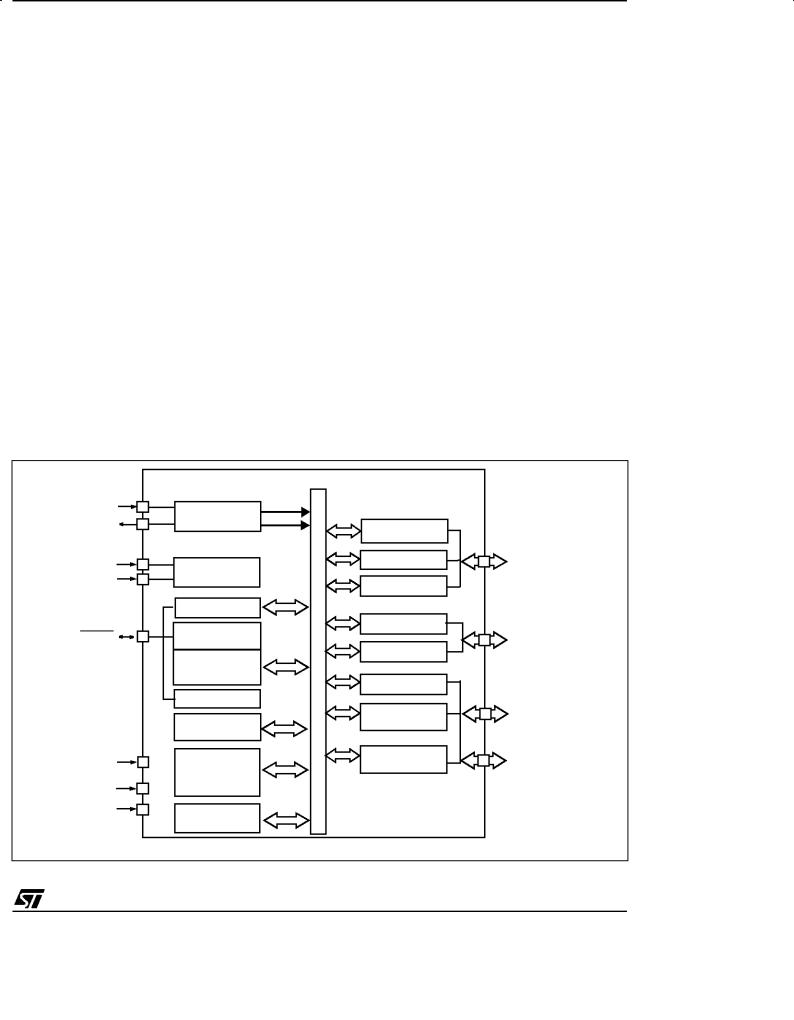
1 GENERAL DESCRIPTION
1.1 INTRODUCTION
The ST7263 Microcontrollers form a sub family of the ST7 dedicated to USB applications. The devices are based on an industry-standard 8-bit core and feature an enhanced instruction set. They operate at a 24MHz or 12 MHz oscillator frequency. Under software control, the ST7263 MCUs may be placed in either Wait or Halt modes, thus reducing power consumption. The enhanced instruction set and addressing modes afford real programming potential. In addition to standard 8-bit data management, the ST7263 MCUs feature true bit manipulation, 8x8 unsigned multiplication and indirect addressing modes. The devices include an ST7 Core, up to 16K program memory, up to 512 bytes RAM, 19 I/O lines and the following on-chip peripherals:
±USB low speed interface with 3 endpoints with programmable in/out configuration using the DMA architecture with embedded 3.3V voltage regulator and transceivers (no external components are needed).
±8-bit Analog-to-Digital converter (ADC) with 8 multiplexed analog inputs
Figure 1. General Block Diagram
|
Internal |
|
|
|
CLOCK |
|
|
OSCIN |
OSC/3 |
|
|
|
|
||
OSCOUT |
OSCILLATOR |
|
|
|
|
||
|
OSC/4 or OSC/2 |
|
|
|
(for USB) |
|
|
VDD |
POWER |
|
|
VSS |
SUPPLY |
|
|
|
WATCH DOG |
ADDRESS |
|
RESET |
CONTROL |
||
|
|||
|
8-BIT CORE |
DATA AND |
|
|
ALU |
||
|
LVD |
||
|
USB DMA |
BUS |
|
|
|
||
VPP/TEST |
PROGRAM |
|
|
|
MEMORY |
|
|
VDDA |
(4K/8K/16K Bytes) |
|
|
VSSA |
RAM |
|
|
|
(256/512 Bytes) |
|
* not on all products (refer to Table 1: Device Summary)
ST7263
± industry standard asynchronous SCI serial interface (not on all products - see device summary below)
±digital Watchdog
±16-bit Timer featuring an External clock input, 2 Input Captures, 2 Output Compares with Pulse Generator capabilities
±fast I2C Multi Master interface (not on all products - see device summary)
±Low voltage reset ensuring proper power-on or power-off of the device
All ST7263 MCUs are available in ROM and OTP versions.
The ST72E631 is the EPROM version of the ST7263 in CSDIP32 windowed packages.
A specific mode is available to allow programming of the EPROM user memory array. This is set by a specific voltage source applied to the VPP/TEST pin.
I2C*
PORT A |
PA[7:0] |
|
(8 bits) |
||
|
||
16-BIT TIMER |
|
|
PORT B |
PB[7:0] |
|
|
||
ADC |
(8 bits) |
|
|
||
PORT C |
|
|
SCI* |
PC[2:0] |
|
(UART) |
(3 bits) |
|
|
||
USB SIE |
USBDP |
|
|
USBDM |
|
|
USBVCC |
5/107
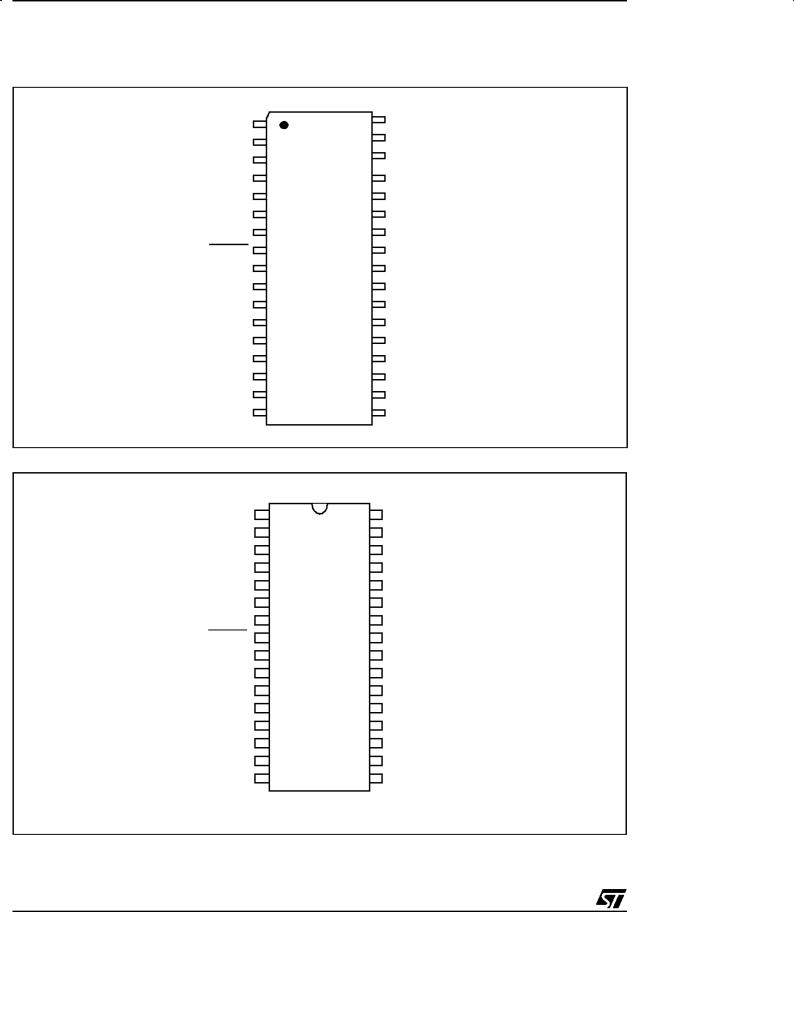
ST7263
1.2 PIN DESCRIPTION
Figure 2. 34-Pin SO Package Pinout
VDD |
1 |
34 |
VDDA |
|
OSCOUT |
2 |
33 |
USBVCC |
|
|
USBDM |
|||
OSCIN |
3 |
32 |
||
|
||||
VSS |
4 |
31 |
USBDP |
|
PC2/USBOE |
5 |
30 |
VSSA |
|
PC1/TDO |
6 |
29 |
PA0/MCO |
|
PC0/RDI |
7 |
28 |
PA1(25mA)/SDA |
|
RESET |
8 |
27 |
NC |
|
NC |
9 |
26 |
NC |
|
AIN7/IT8/PB7(10mA) |
10 |
25 |
NC |
|
AIN6/IT7/PB6(10mA) |
11 |
24 |
PA2(25mA)/SCL |
|
VPP/TEST |
12 |
23 |
PA3/EXTCLK |
|
AIN5/IT6/PB5(10mA) |
13 |
22 |
PA4/ICAP1/IT1 |
|
AIN4/IT5/PB4(10mA) |
14 |
21 |
PA5/ICAP2/IT2 |
|
AIN3/PB3(10mA) |
15 |
20 |
PA6/OCMP1/IT3 |
|
AIN2/PB2(10mA) |
16 |
19 |
PA7/OCMP2/IT4 |
|
AIN1/PB1(10mA) |
17 |
18 |
PB0(10mA)/AIN0 |
|
* VPP on EPROM/OTP versions only |
|
|
|
|
Figure 3. 32-Pin SDIP Package Pinout |
|
|
|
|
VDD |
1 |
32 |
VDDA |
|
OSCOUT |
2 |
31 |
USBVCC |
|
OSCIN |
3 |
30 |
USBDM |
|
VSS |
4 |
29 |
USBDP |
|
PC2/USBOE |
5 |
28 |
VSSA |
|
PC1/TDO |
6 |
27 |
PA0/MCO |
|
PC0/RDI |
7 |
26 |
PA1(25mA)/SDA |
|
RESET |
8 |
25 |
NC |
|
AIN7/IT8/PB7(10mA) |
9 |
24 |
NC |
|
AIN6/IT7/PB6(10mA) |
10 |
23 |
PA2(25mA)/SCL |
|
VPP/TEST* |
11 |
22 |
PA3/EXTCLK |
|
AIN5/IT6/PB5(10mA) |
12 |
21 |
PA4/ICAP1/IT1 |
|
AIN4/IT5/PB4(10mA) |
13 |
20 |
PA5/ICAP2/IT2 |
|
AIN3/PB3(10mA) |
14 |
19 |
PA6/COMP1/IT3 |
|
AIN2/PB2(10mA) |
15 |
18 |
PA7/COMP2/IT4 |
|
AIN1/PB1/(10mA) |
16 |
17 |
PB0(10mA)/AIN0 |
* VPP on EPROM/OTP versions only
6/107
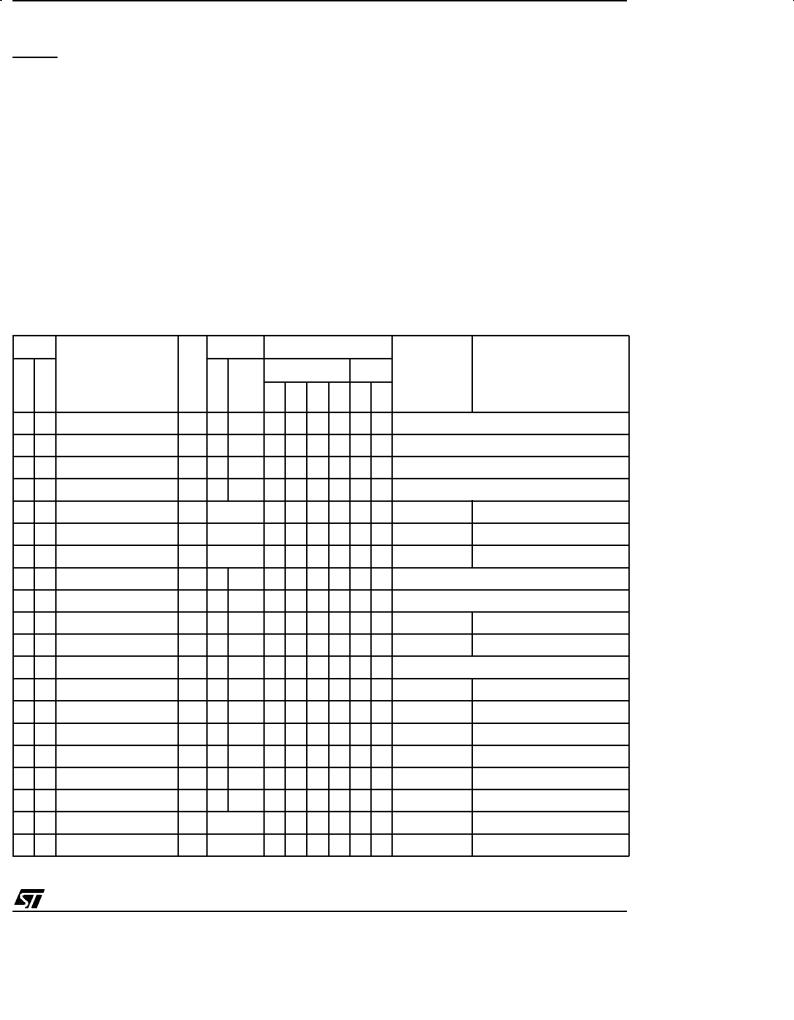
ST7263
PIN DESCRIPTION (Cont'd)
RESET (see Note 1): Bidirectional. This active low signal forces the initialization of the MCU. This event is the top priority non maskable interrupt. This pin is switched low when the Watchdog has triggered or VDD is low. It can be used to reset external peripherals.
OSCIN/OSCOUT: Input/Output Oscillator pin. These pins connect a parallel-resonant crystal, or an external source to the on-chip oscillator.
VPP/TEST: EPROM programming input. This pin must be held low during normal operating modes.
VDD/VSS (see Note 2): Main power supply and Ground voltages.
VDDA/VSSA (see Note 2): Power Supply and Ground for analog peripherals.
Table 2. Device Pin Description
Alternate Functions: Several pins of the I/O ports assume software programmable alternate functions as shown in the pin description.
Note 1: Adding two 100nF decoupling capacitors on Reset pin (respectively connected to VDD and VSS) will significantly improve product electromagnetic susceptibility performances.
Note 2: To enhance reliability of operation, it is recommended to connect VDDA and VDD together on the application board. The same recommendations apply to VSSA and VSS.
Pin n° |
|
|
SDIP32 |
SO34 |
Pin Name |
|
|
|
1 |
1 |
VDD |
2 |
2 |
OSCOUT |
3 |
3 |
OSCIN |
4 |
4 |
VSS |
5 |
5 |
PC2/USBOE |
6 |
6 |
PC1/TDO |
7 |
7 |
PC0/RDI |
8 |
8 |
RESET |
--9 NC
9 |
10 |
PB7/AIN7/IT8 |
10 |
11 |
PB6/AIN6/IT7 |
11 |
12 |
VPP/TEST |
12 |
13 |
PB5/AIN5/IT6 |
13 |
14 |
PB4/AIN4/IT5 |
14 |
15 |
PB3/AIN3 |
15 |
16 |
PB2/AIN2 |
16 |
17 |
PB1/AIN1 |
17 |
18 |
PB0/AIN0 |
18 |
19 |
PA7/OCMP2/IT4 |
19 |
20 |
PA6/OCMP1/IT3 |
|
Level |
|
|
Type |
Input |
Output |
float |
S |
|
|
|
O |
|
|
|
I |
|
|
|
S |
|
|
|
I/O |
|
CT |
|
I/O |
|
CT |
|
I/O |
|
CT |
|
I/O |
|
|
|
-- |
|
|
|
I/O |
CT 10mA |
X |
|
I/O |
CT 10mA |
X |
|
S |
|
|
|
I/O |
CT 10mA |
X |
|
I/O |
CT 10mA |
X |
|
I/O |
CT 10mA |
X |
|
I/O |
CT 10mA |
X |
|
I/O |
CT 10mA |
X |
|
I/O |
CT 10mA |
X |
|
I/O |
|
CT |
|
I/O |
|
CT |
|
Port / Control |
|
Main |
|
|||
Input |
|
Output |
|
|||
|
Function |
Alternate Function |
||||
wpu |
int |
ana |
OD |
PP |
(after reset) |
|
|
|
|||||
|
|
|
|
|
Power supply voltage (4V - 5.5V) |
|
|
|
|
|
|
Oscillator output |
|
|
|
|
|
|
Oscillator input |
|
|
|
|
|
|
Digital ground |
|
X |
|
|
|
X |
Port C2 |
USB Output Enable |
X |
|
|
|
X |
Port C1 |
SCI transmit data output *) |
X |
|
|
|
X |
Port C0 |
SCI Receive Data Input *) |
X |
|
|
X |
|
Reset |
|
|
|
|
|
|
Not connected |
|
|
X |
X |
|
X |
Port B7 |
ADC analog input 7 |
|
X |
X |
|
X |
Port B6 |
ADC analog input 6 |
|
|
|
|
|
Supply for EPROM and test input |
|
|
X |
X |
|
X |
Port B5 |
ADC analog input 5 |
|
X |
X |
|
X |
Port B4 |
ADC analog input 4 |
|
|
X |
|
X |
Port B3 |
ADC analog input 3 |
|
|
X |
|
X |
Port B2 |
ADC analog input 2 |
|
|
X |
|
X |
Port B1 |
ADC analog input 1 |
|
|
X |
|
X |
Port B0 |
ADC Analog Input 0 |
X |
X |
|
|
X |
Port A7 |
Timer Output Compare 2 |
X |
X |
|
|
X |
Port A6 |
Timer Output Compare 1 |
7/107
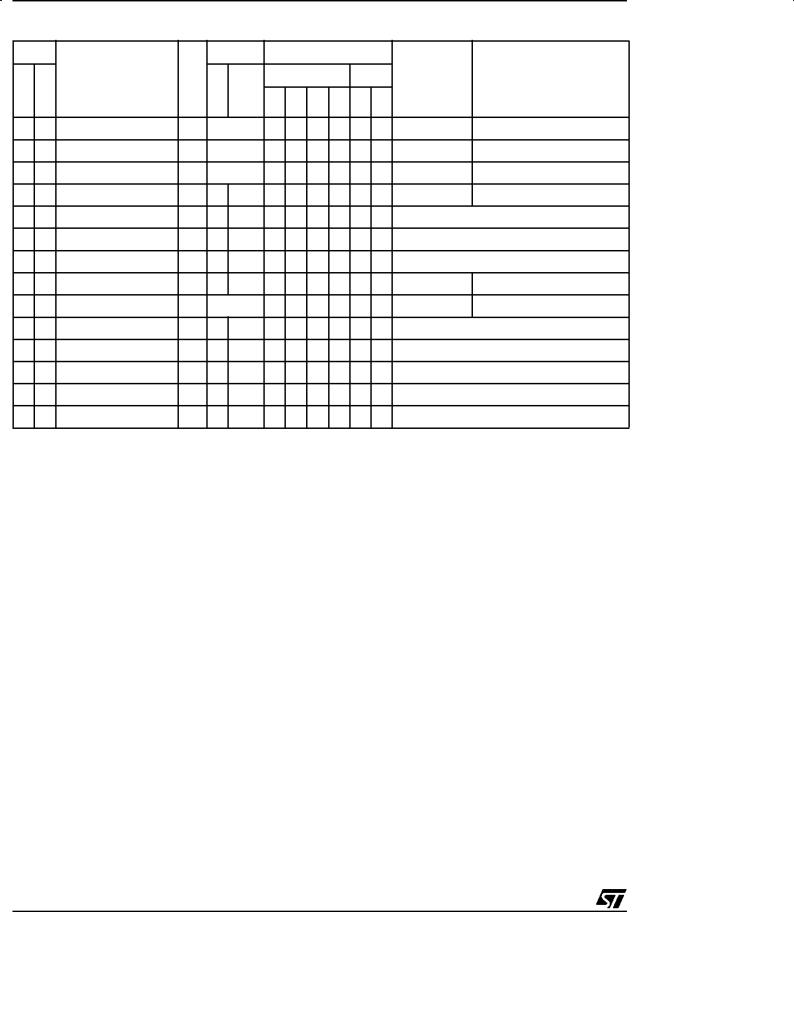
ST7263
Pin n° |
|
|
SDIP32 |
SO34 |
Pin Name |
|
|
|
20 |
21 |
PA5/ICAP2/IT2 |
21 |
22 |
PA4/ICAP1/IT1 |
22 |
23 |
PA3/EXTCLK |
23 |
24 |
PA2/SCL |
-- |
25 |
NC |
24 |
26 |
NC |
25 |
27 |
NC |
26 |
28 |
PA1/SDA |
27 |
29 |
PA0/MCO |
28 |
30 |
VSSA |
29 |
31 |
USBDP |
30 |
32 |
USBDM |
31 |
33 |
USBVCC |
32 |
34 |
VDDA |
|
Level |
|
|
Type |
Input |
Output |
float |
I/O |
|
CT |
|
I/O |
|
CT |
|
I/O |
|
CT |
|
I/O |
CT 25mA |
X |
|
-- |
|
|
|
-- |
|
|
|
-- |
|
|
|
I/O |
CT 25mA |
X |
|
I/O |
|
CT |
|
S |
|
|
|
I/O |
|
|
|
I/O
O
S
Port / Control |
|
Main |
|
|||
Input |
|
Output |
|
|||
|
Function |
Alternate Function |
||||
wpu |
int |
ana |
OD |
PP |
(after reset) |
|
|
|
|||||
X |
X |
|
|
X |
Port A5 |
Timer Input Capture 2 |
X |
X |
|
|
X |
Port A4 |
Timer Input Capture 1 |
X |
|
|
|
X |
Port A3 |
Timer External Clock |
|
|
|
X |
|
Port A2 |
I2C serial clock *) |
|
|
|
|
|
Not connected |
|
|
|
|
|
|
Not connected |
|
|
|
|
|
|
Not connected |
|
|
|
|
X |
|
Port A1 |
I2C serial data *) |
|
X |
|
|
X |
Port A0 |
Main Clock Output |
Analog ground
USB bidirectional data (data +)
USB bidirectional data (data -)
USB power supply
Analog supply voltage
*: if the peripheral is present on the device (see Table 1 Device Summary)
Legend / Abbreviations of Figure 2 and Table 2:
Type: |
I = input, O = output, S = supply |
In/Output level: |
CT = CMOS 0.3VDD/0.7VDD with input trigger |
Output level: |
10mA = 10mA high sink (on N-buffer only) |
|
|
25mA = 25mA very high sink (on N-buffer only) |
Port and control configuration: |
||
± |
Input: |
float = floating, wpu = weak pull-up, int = interrupt, ana = analog |
± |
Output: |
OD = open drain, PP = push-pull |
Refer to ªI/O PORTSº on page 25 for more details on the software configuration of the I/O ports.
The RESET configuration of each pin is shown in bold. This configuration is kept as long as the device is under reset state.
8/107
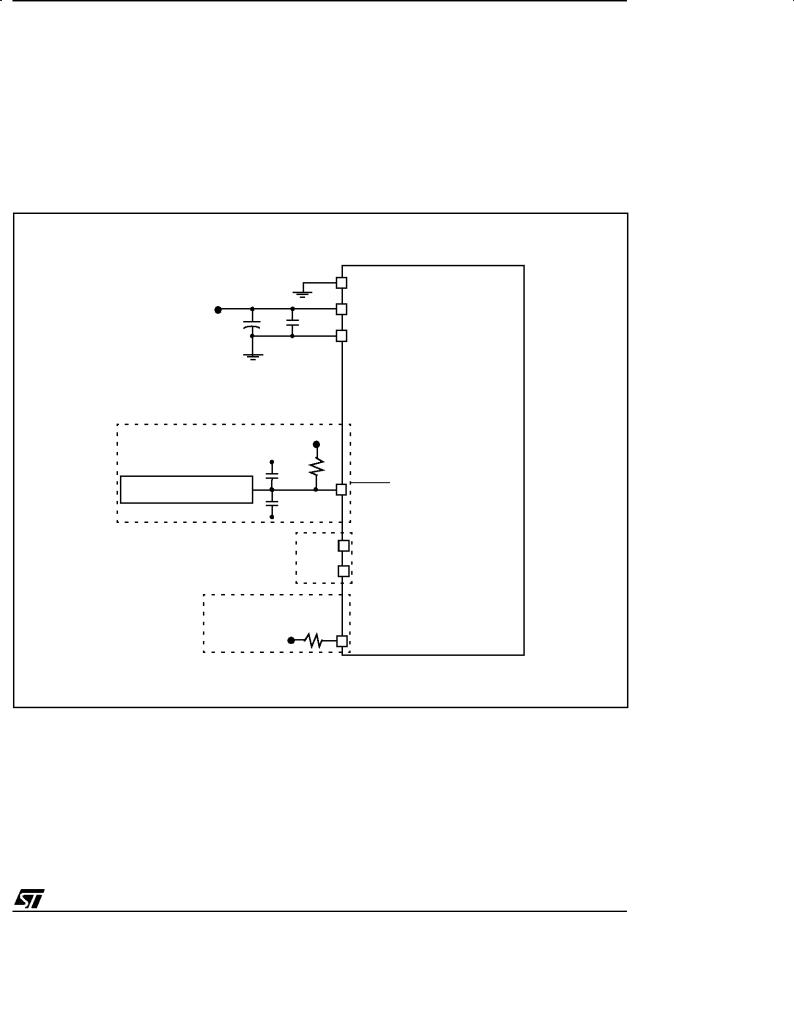
ST7263
1.3 EXTERNAL CONNECTIONS
The following figure shows the recommended external connections for the device.
The VPP pin is only used for programming OTP and EPROM devices and must be tied to ground in user mode.
The 10 nF and 0.1 μF decoupling capacitors on the power supply lines are a suggested EMC performance/cost tradeoff.
Figure 4. Recommended External Connections
The external reset network is intended to protect the device against parasitic resets, especially in noisy environments.
Unused I/Os should be tied high to avoid any unnecessary power consumption on floating lines. An alternative solution is to program the unused ports as inputs with pull-up.
VPP
VDD |
+ |
|
|
10nF |
0.1μF |
||
|
Optional if Low Voltage |
|
Detector (LVD) is used |
VDD |
|
|
|
4.7K |
|
0.1μF |
EXTERNAL RESET CIRCUIT |
|
|
0.1μF |
|
See |
|
Clocks |
|
Section |
Or configure unused I/O ports by software as input with pull-up
10K
VDD
VDD
VSS
RESET
OSCIN
OSCOUT
Unused I/O
9/107
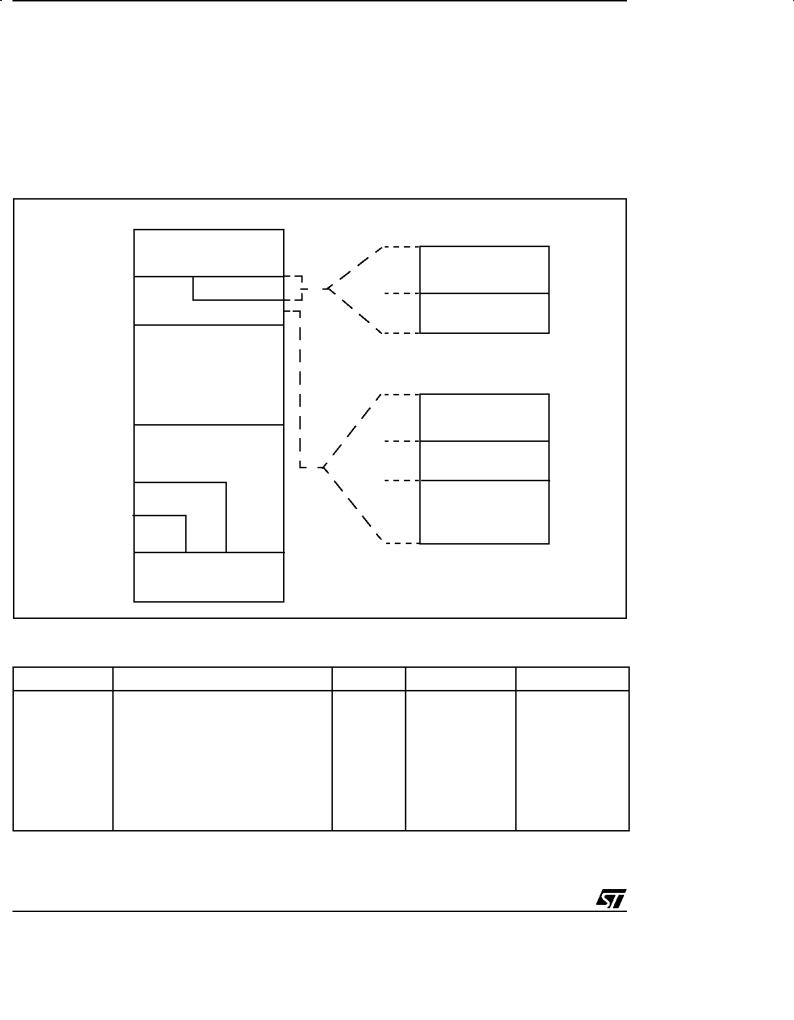
ST7263
1.4 REGISTER & MEMORY MAP
As shown in Figure 5, the MCU is capable of addressing 64K bytes of memories and I/O registers.
The available memory locations consist of 192 bytes of register location, up to 512 bytes of RAM and up to 16K bytes of user program memory. The RAM space includes up to 64 bytes for the stack from 0100h to 013Fh.
The highest address bytes contain the user reset and interrupt vectors.
IMPORTANT: Memory locations noted ªReservedº must never be accessed. Accessing a reserved area can have unpredictable effects on the device
Figure 5. Memory Map
0000h |
HW Registers |
|
|
|
(see Table 4 |
0040h |
|
003Fh |
|
Short Addressing |
|
|
RAM (192 Bytes) |
||
0040h |
|
||
256 Bytes RAM* |
00FFh |
||
|
|||
|
0100h |
||
|
|
||
023Fh |
512 Bytes RAM* |
Stack (64 Bytes) |
|
|
013Fh |
||
0240h |
|
||
|
|
||
|
Reserved |
|
|
|
|
0040h |
|
BFFFh |
|
Short Addressing |
|
|
RAM (192 Bytes) |
||
C000h |
|
||
Program Memory* |
00FFh |
||
|
|||
|
0100h |
||
|
|
||
|
16K Bytes |
Stack (64 Bytes) |
|
|
013Fh |
||
E000h |
|
0140h |
|
|
8K Bytes |
16-bit Addressing RAM |
|
F000h |
|
||
4K Bytes |
(256 Bytes) |
||
|
023Fh |
FFEFh
FFF0h
Interrupt & Reset Vectors (see Table 3 on page 10)
FFFFh
*Program memory and RAM sizes are product dependent (see Table 1 Device Summary)
Table 3. Interrupt Vector Map
Vector Address |
Description |
Masked by |
Remarks |
Exit from Halt Mode |
FFF0-FFF1h |
USB Interrupt Vector |
I- bit |
Internal Interrupt |
No |
FFF2-FFF3h |
SCI Interrupt Vector* |
I- bit |
Internal Interrupt |
No |
FFF4-FFF5h |
I2C Interrupt Vector* |
I- bit |
Internal Interrupt |
No |
FFF6-FFF7h |
TIMER Interrupt Vector |
I- bit |
Internal Interrupt |
No |
FFF8-FFF9h |
IT1 to IT8 Interrupt Vector |
I- bit |
External Interrupts |
Yes |
FFFA-FFFB h |
USB End Suspend Mode Interrupt Vector |
I- bit |
Internal Interrupt |
Yes |
FFFC-FFFDh |
TRAP (software) Interrupt Vector |
none |
CPU Interrupt |
No |
FFFE-F FFFh |
RESET Vector |
none |
|
Yes |
* If the peripheral is present on the device (see Table 1 Device Summary)
10/107
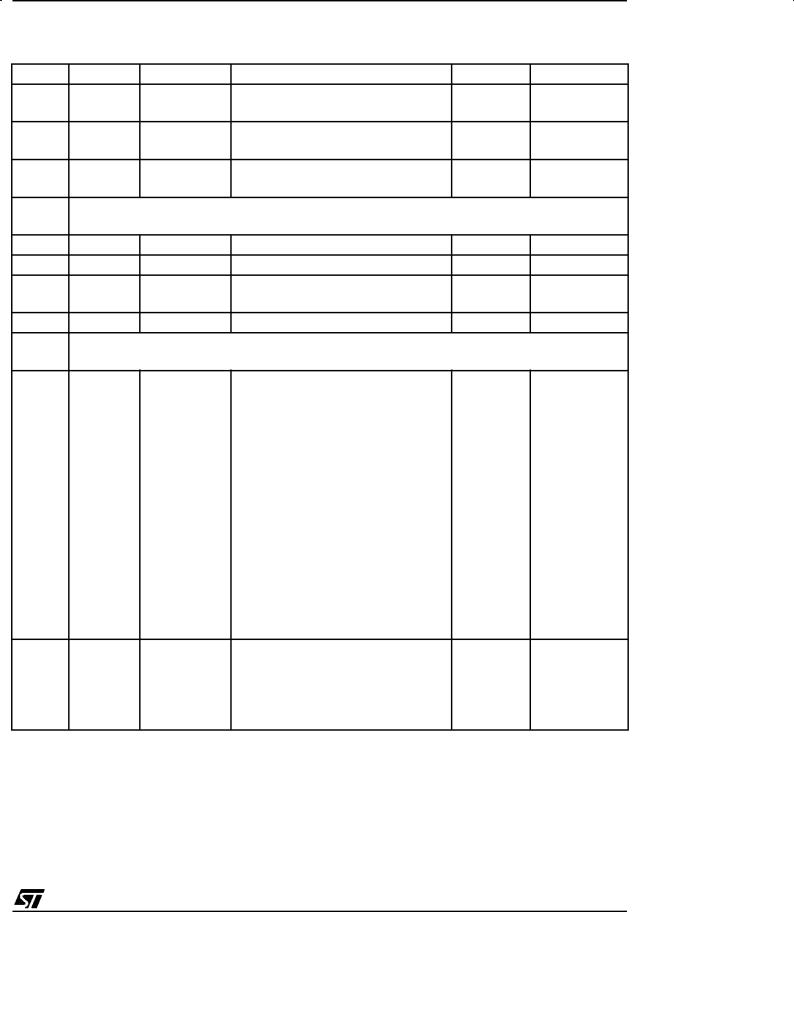
ST7263
Table 4. Hardware Register Memory Map
Address
0000h
0001h
0002h
0003h
0004h
0005h
0006h
0007h
0008h
0009h
000Ah
000Bh
000Ch
000Dh
0010h
0011h
0012h
0013h
0014h
0015h
0016h
0017h
0018h
0019h
001Ah
001Bh
001Ch
001Dh
001Eh
001Fh
0020h
0021h
0022h
0023h
0024h
Block
ADC
WDG
TIM
SCI 1)
Register Label |
Register name |
Reset Status |
Remarks |
PADR |
Port A Data Register |
00h |
R/W |
PADDR |
Port A Data Direction Register |
00h |
R/W |
PBDR |
Port B Data Register |
00h |
R/W |
PBDDR |
Port B Data Direction Register |
00h |
R/W |
PCDR |
Port C Data Register |
1111 x000b |
R/W |
PCDDR |
Port C Data Direction Register |
1111 x000b |
R/W |
|
Reserved (2 Bytes) |
|
|
ITIFRE |
Interrupt Register |
00h |
R/W |
MISCR |
Miscellaneous Register |
F0h |
R/W |
DR |
ADC Data Register |
00h |
Read only |
CSR |
ADC control Status register |
00h |
R/W |
CR |
Watchdog Control Register |
7Fh |
R/W |
|
Reserved (4 Bytes) |
|
|
CR2 |
Timer Control Register 2 |
00h |
R/W |
CR1 |
Timer Control Register 1 |
00h |
R/W |
SR |
Timer Status Register |
00h |
Read only |
IC1HR |
Timer Input Capture High Register 1 |
xxh |
Read only |
IC1LR |
Timer Input Capture Low Register 1 |
xxh |
Read only |
OC1HR |
Timer Output Compare High Register 1 |
80h |
R/W |
OC1LR |
Timer Output Compare Low Register 1 |
00h |
R/W |
CHR |
Timer Counter High Register |
FFh |
Read only |
CLR |
Timer Counter Low Register |
FCh |
R/W |
ACHR |
Timer Alternate Counter High Register |
FFh |
Read only |
ACLR |
Timer Alternate Counter Low Register |
FCh |
R/W |
IC2HR |
Timer Input Capture High Register 2 |
xxh |
Read only |
IC2LR |
Timer Input Capture Low Register 2 |
xxh |
Read only |
OC2HR |
Timer Output Compare High Register 2 |
80h |
R/W |
OC2LR |
Timer Output Compare Low Register 2 |
00h |
R/W |
SR |
SCI Status Register |
C0h |
Read only |
DR |
SCI Data Register |
xxh |
R/W |
BRR |
SCI Baud Rate Register |
00xx xxxxb |
R/W |
CR1 |
SCI Control Register 1 |
xxh |
R/W |
CR2 |
SCI Control Register 2 |
00h |
R/W |
11/107
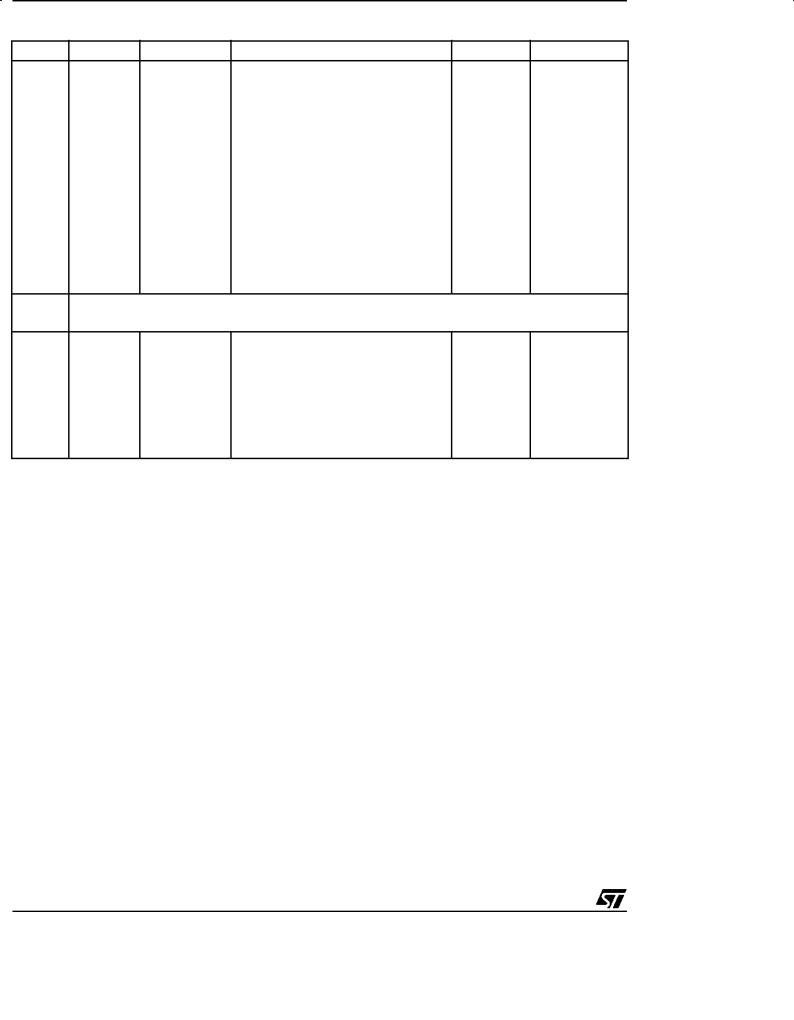
ST7263
Address |
Block |
Register Label |
Register name |
Reset Status |
Remarks |
0025h |
|
PIDR |
USB PID Register |
xxh |
Read only |
0026h |
|
DMAR |
USB DMA address Register |
xxh |
R/W |
0027h |
|
IDR |
USB Interrupt/DMA Register |
xxh |
R/W |
0028h |
|
ISTR |
USB Interrupt Status Register |
00h |
R/W |
0029h |
|
IMR |
USB Interrupt Mask Register |
00h |
R/W |
002Ah |
|
CTLR |
USB Control Register |
xxxx 0110b |
R/W |
002Bh |
USB |
DADDR |
USB Device Address Register |
00h |
R/W |
002Ch |
|
EP0RA |
USB Endpoint 0 Register A |
0000 xxxxb |
R/W |
002Dh |
|
EP0RB |
USB Endpoint 0 Register B |
80h |
R/W |
002Eh |
|
EP1RA |
USB Endpoint 1 Register A |
0000 xxxxb |
R/W |
002Fh |
|
EP1RB |
USB Endpoint 1 Register B |
0000 xxxxb |
R/W |
0030h |
|
EP2RA |
USB Endpoint 2 Register A |
0000 xxxxb |
R/W |
0031h |
|
EP2RB |
USB Endpoint 2 Register B |
0000 xxxxb |
R/W |
0032h |
|
|
Reserved (7 Bytes) |
|
|
0038h |
|
|
|
|
|
|
|
|
|
|
|
0039h |
|
DR |
I2C Data Register |
00h |
R/W |
003Ah |
I2C1) |
|
Reserved |
- |
|
003Bh |
|
OAR |
I2C (7 Bits) Slave Address Register |
00h |
R/W |
003Ch |
|
CCR |
I2C Clock Control Register |
00h |
R/W |
003Dh |
|
SR2 |
I2C 2nd Status Register |
00h |
Read only |
003Eh |
|
SR1 |
I2C 1st Status Register |
00h |
Read only |
003Fh |
|
CR |
I2C Control Register |
00h |
R/W |
Note 1. If the peripheral is present on the device (see Table 1 Device Summary)
12/107

1.5 EPROM/OTP PROGRAM MEMORY
The program memory of the ST72T63 may be programmed using the EPROM programming boards available from STMicroelectronics (see Table 26).
1.5.1 EPROM ERASURE
ST72Exxx EPROM devices are erased by exposure to high intensity UV light admitted through the transparent window. This exposure discharges the floating gate to its initial state through induced photo current.
It is recommended that the ST72Exxx devices be kept out of direct sunlight, since the UV content of sunlight can be sufficient to cause functional failure. Extended exposure to room level fluorescent lighting may also cause erasure.
ST7263
An opaque coating (paint, tape, label, etc...) should be placed over the package window if the product is to be operated under these lighting conditions. Covering the window also reduces IDD in power-saving modes due to photo-diode leakage currents.
An Ultraviolet source of wave length 2537 Å yielding a total integrated dosage of 15 Watt-sec/cm2 is required to erase the ST72Exxx. The device will be erased in 15 to 30 minutes if such a UV lamp with a 12mW/cm2 power rating is placed 1 inch from the device window without any interposed filters.
13/107
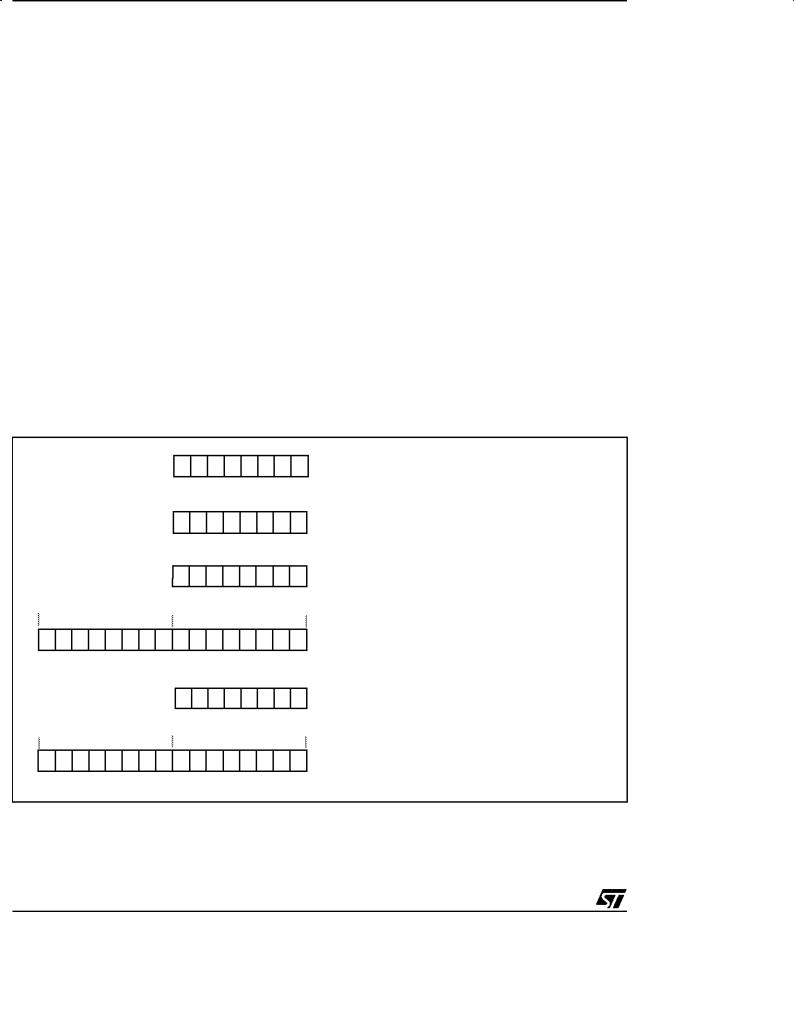
ST7263
2 CENTRAL PROCESSING UNIT
2.1 INTRODUCTION
This CPU has a full 8-bit architecture and contains six internal registers allowing efficient 8-bit data manipulation.
2.2 MAIN FEATURES
■63 basic instructions
■Fast 8-bit by 8-bit multiply
■17 main addressing modes
■Two 8-bit index registers
■16-bit stack pointer
■Low power modes
■Maskable hardware interrupts
■Non-maskable software interrupt
2.3 CPU REGISTERS
The 6 CPU registers shown in Figure 6 are not present in the memory mapping and are accessed by specific instructions.
Figure 6. CPU Registers
|
|
|
7 |
|
|
|
|
|
|
0 |
|
|
|
RESET VALUE = XXh |
|
||||||
|
|
|
7 |
|
|
|
|
|
|
0 |
|
|
|
RESET VALUE = XXh |
|
||||||
|
|
|
7 |
|
|
|
|
|
|
0 |
|
|
|
RESET VALUE = XXh |
|
||||||
15 |
PCH |
8 |
7 |
|
|
PCL |
|
|
0 |
|
RESET VALUE = RESET VECTOR @ FFFEh-FFFFh |
||||||||||
|
|
|
7 |
|
|
|
|
|
|
0 |
|
|
|
1 |
1 |
1 |
H |
I |
N |
Z |
C |
|
RESET VALUE = 1 |
1 |
1 |
X |
1 |
X |
X |
X |
||
15 |
|
8 |
7 |
|
|
|
|
|
|
0 |
RESET VALUE = STACK HIGHER ADDRESS
Accumulator (A)
The Accumulator is an 8-bit general purpose register used to hold operands and the results of the arithmetic and logic calculations and to manipulate data.
Index Registers (X and Y)
In indexed addressing modes, these 8-bit registers are used to create either effective addresses or temporary storage areas for data manipulation. (The Cross-Assembler generates a precede instruction (PRE) to indicate that the following instruction refers to the Y register.)
The Y register is not affected by the interrupt automatic procedures (not pushed to and popped from the stack).
Program Counter (PC)
The program counter is a 16-bit register containing the address of the next instruction to be executed by the CPU. It is made of two 8-bit registers PCL (Program Counter Low which is the LSB) and PCH (Program Counter High which is the MSB).
ACCUMULATOR
XINDEX REGISTER
YINDEX REGISTER
PROGRAM COUNTER
CONDITION CODE REGISTER
STACK POINTER
X = Undefined Value
14/107
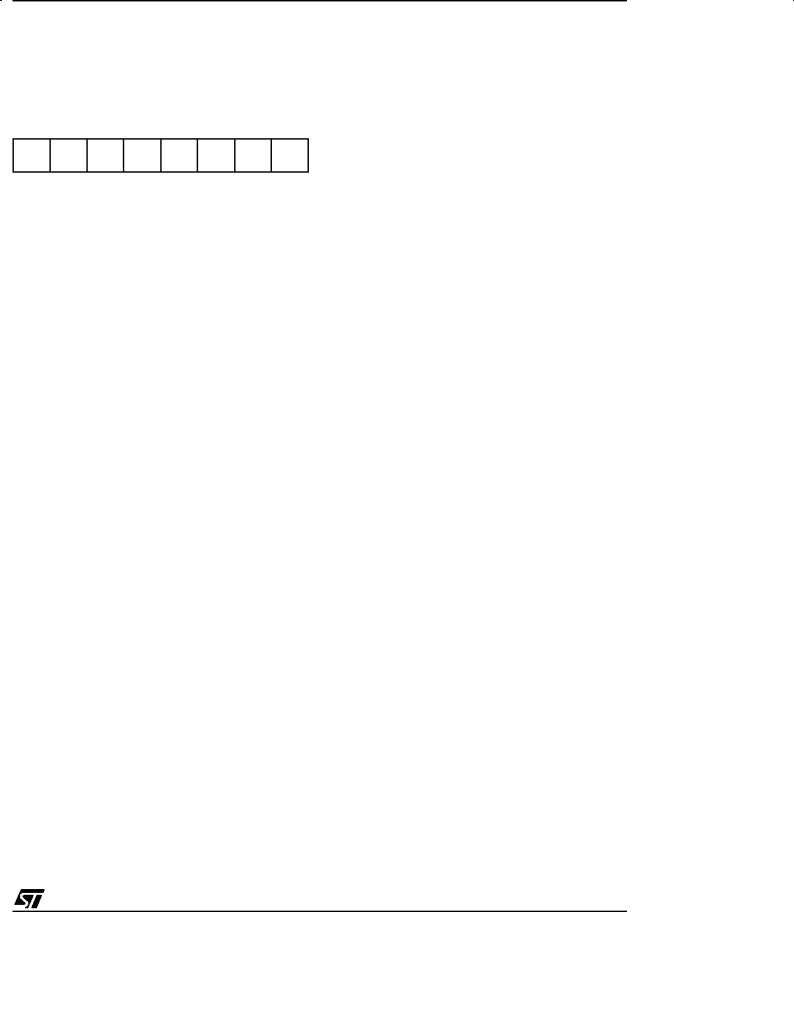
CPU REGISTERS (Cont'd)
CONDITION CODE REGISTER (CC)
Read/Write
Reset Value: 111x1xxx
7 |
|
|
|
|
|
|
0 |
1 |
1 |
1 |
H |
I |
N |
Z |
C |
The 8-bit Condition Code register contains the interrupt mask and four flags representative of the result of the instruction just executed. This register can also be handled by the PUSH and POP instructions.
These bits can be individually tested and/or controlled by specific instructions.
Bit 4 = H Half carry.
This bit is set by hardware when a carry occurs between bits 3 and 4 of the ALU during an ADD or ADC instruction. It is reset by hardware during the same instructions.
0:No half carry has occurred.
1:A half carry has occurred.
This bit is tested using the JRH or JRNH instruction. The H bit is useful in BCD arithmetic subroutines.
Bit 3 = I Interrupt mask.
This bit is set by hardware when entering in interrupt or by software to disable all interrupts except the TRAP software interrupt. This bit is cleared by software.
0:Interrupts are enabled.
1:Interrupts are disabled.
This bit is controlled by the RIM, SIM and IRET instructions and is tested by the JRM and JRNM instructions.
Note: Interrupts requested while I is set are latched and can be processed when I is cleared. By default an interrupt routine is not interruptable because the I bit is set by hardware when you en-
ST7263
ter it and reset by the IRET instruction at the end of the interrupt routine. If the I bit is cleared by software in the interrupt routine, pending interrupts are serviced regardless of the priority level of the current interrupt routine.
Bit 2 = N Negative.
This bit is set and cleared by hardware. It is representative of the result sign of the last arithmetic, logical or data manipulation. It is a copy of the 7th bit of the result.
0:The result of the last operation is positive or null.
1:The result of the last operation is negative
(i.e. the most significant bit is a logic 1).
This bit is accessed by the JRMI and JRPL instructions.
Bit 1 = Z Zero.
This bit is set and cleared by hardware. This bit indicates that the result of the last arithmetic, logical or data manipulation is zero.
0:The result of the last operation is different from zero.
1:The result of the last operation is zero.
This bit is accessed by the JREQ and JRNE test instructions.
Bit 0 = C Carry/borrow.
This bit is set and cleared by hardware and software. It indicates an overflow or an underflow has occurred during the last arithmetic operation.
0:No overflow or underflow has occurred.
1:An overflow or underflow has occurred.
This bit is driven by the SCF and RCF instructions and tested by the JRC and JRNC instructions. It is also affected by the ªbit test and branchº, shift and rotate instructions.
15/107
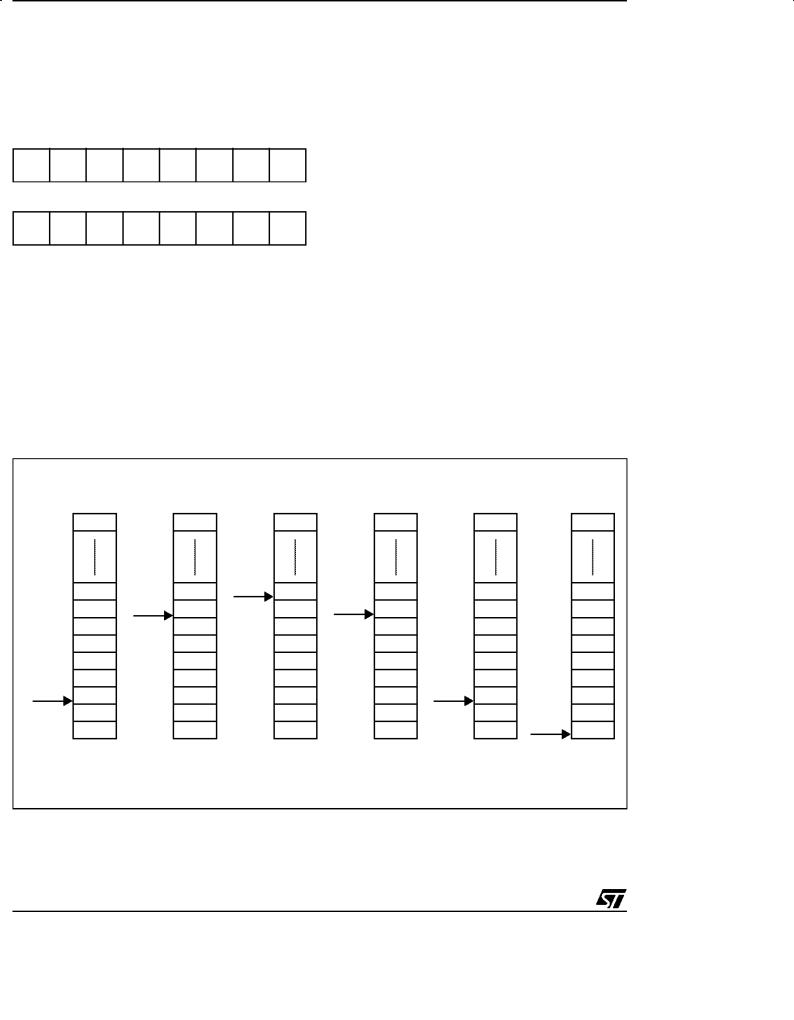
ST7263
CPU REGISTERS (Cont'd)
Stack Pointer (SP)
Read/Write
Reset Value: 01 3Fh
15 |
|
|
|
|
|
|
8 |
0 |
0 |
0 |
0 |
0 |
0 |
0 |
1 |
7 |
|
|
|
|
|
|
0 |
0 |
0 |
SP5 |
SP4 |
SP3 |
SP2 |
SP1 |
SP0 |
The Stack Pointer is a 16-bit register which is always pointing to the next free location in the stack. It is then decremented after data has been pushed onto the stack and incremented before data is popped from the stack (see Figure 7).
Since the stack is 64 bytes deep, the 10 most significant bits are forced by hardware. Following an MCU Reset, or after a Reset Stack Pointer instruction (RSP), the Stack Pointer contains its reset value (SP5 to SP0 bits are set) which is the stack higher address.
Figure 7. Stack Manipulation Example
The least significant byte of the Stack Pointer (called S) can be directly accessed by a LD instruction.
Note: When the lower limit is exceeded, the Stack Pointer wraps around to the stack upper limit, without indicating the stack overflow. The previously stored information is then overwritten and therefore lost. The stack also wraps in case of an underflow.
The stack is used to save the return address during a subroutine call and the CPU context during an interrupt. The user may also directly manipulate the stack by means of the PUSH and POP instructions. In the case of an interrupt, the PCL is stored at the first location pointed to by the SP. Then the other registers are stored in the next locations as shown in Figure 7.
±When an interrupt is received, the SP is decremented and the context is pushed on the stack.
±On return from interrupt, the SP is incremented and the context is popped from the stack.
A subroutine call occupies two locations and an interrupt five locations in the stack area.
CALL |
Interrupt |
PUSH Y |
POP Y |
IRET |
RET |
Subroutine |
Event |
|
|
|
or RSP |
@ 0100h |
|
|
|
|
|
|
|
SP |
|
|
|
|
SP |
Y |
SP |
|
|
|
|
|
|
||
|
CC |
CC |
CC |
|
|
|
A |
A |
A |
|
|
|
X |
X |
X |
|
|
SP |
PCH |
PCH |
PCH |
SP |
|
PCL |
PCL |
PCL |
|||
|
|
||||
PCH |
PCH |
PCH |
PCH |
PCH |
|
@ 013Fh PCL |
PCL |
PCL |
PCL |
SP |
|
PCL |
Stack Higher Address = 013Fh
Stack Lower Address = 0100h
16/107
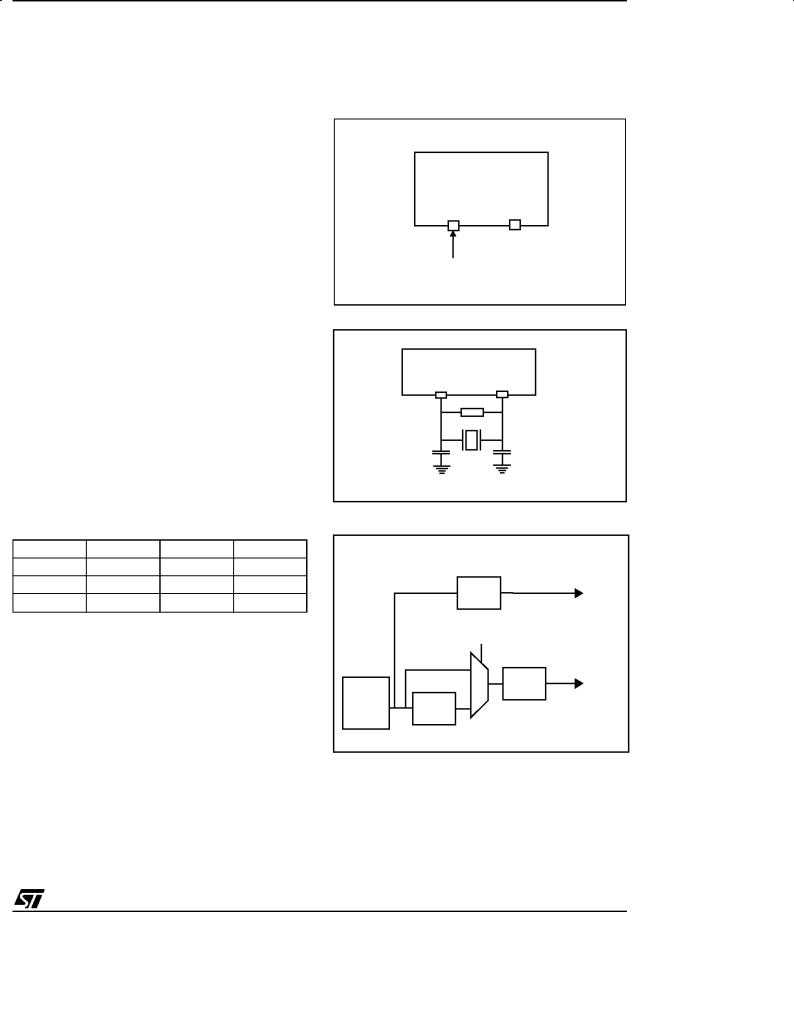
3 CLOCKS AND RESET
3.1 CLOCK SYSTEM
3.1.1 General Description
The MCU accepts either a Crystal or Ceramic resonator, or an external clock signal to drive the internal oscillator. The internal clock (fCPU) is derived from the external oscillator frequency (fOSC), which is divided by 3 (and by 2 or 4 for USB, depending on the external clock used).
By setting the CLKDIV bit in the Miscellaneous Register, a 12 MHz external clock can be used giving an internal frequency of 4 MHz while maintaining a 6 MHz for USB (refer to Figure 10).
The internal clock signal (fCPU) is also routed to the on-chip peripherals. The CPU clock signal consists of a square wave with a duty cycle of 50%.
The internal oscillator is designed to operate with an AT-cut parallel resonant quartz or ceramic resonator in the frequency range specified for fosc. The circuit shown in Figure 9 is recommended when using a crystal, and Table 5 Recommended Values for 24 MHz Crystal Resonator lists the recommended capacitance. The crystal and associated components should be mounted as close as possible to the input pins in order to minimize output distortion and start-up stabilisation time.
Table 5. Recommended Values for 24 MHz Crystal Resonator
RSMAX |
20 Ω |
25 Ω |
70 Ω |
COSCIN |
56pF |
47pF |
22pF |
COSCOUT |
56pF |
47pF |
22pF |
RP |
1-10 MΩ |
1-10 MΩ |
1-10 MΩ |
Note: RSMAX is the equivalent serial resistor of the crystal (see crystal specification).
3.1.2 External Clock
An external clock may be applied to the OSCIN input with the OSCOUT pin not connected, as shown on Figure 8. The tOXOV specifications does not apply when using an external clock input. The equivalent specification of the external clock
source should be used instead of tOXOV (see Section 6.5 CONTROL TIMING).
ST7263
Figure 8. External Clock Source Connections
OSCIN OSCOUT
NC
EXTERNAL
CLOCK
Figure 9. Crystal/Ceramic Resonator
OSCIN OSCOUT
RP
COSCIN |
COSCOUT |
Figure 10. Clock block diagram
|
|
|
8 or 4 MHz |
|
|
|
CPU and |
|
|
%3 |
peripherals) |
|
|
|
|
|
|
CLKDIV |
|
|
|
1 |
6 MHz (USB) |
|
|
|
|
|
|
|
%2 |
24 or |
|
|
%2 |
|
0 |
|
|
12 MHz |
%2 |
|
|
Crystal |
|
|
|
|
|
|
17/107
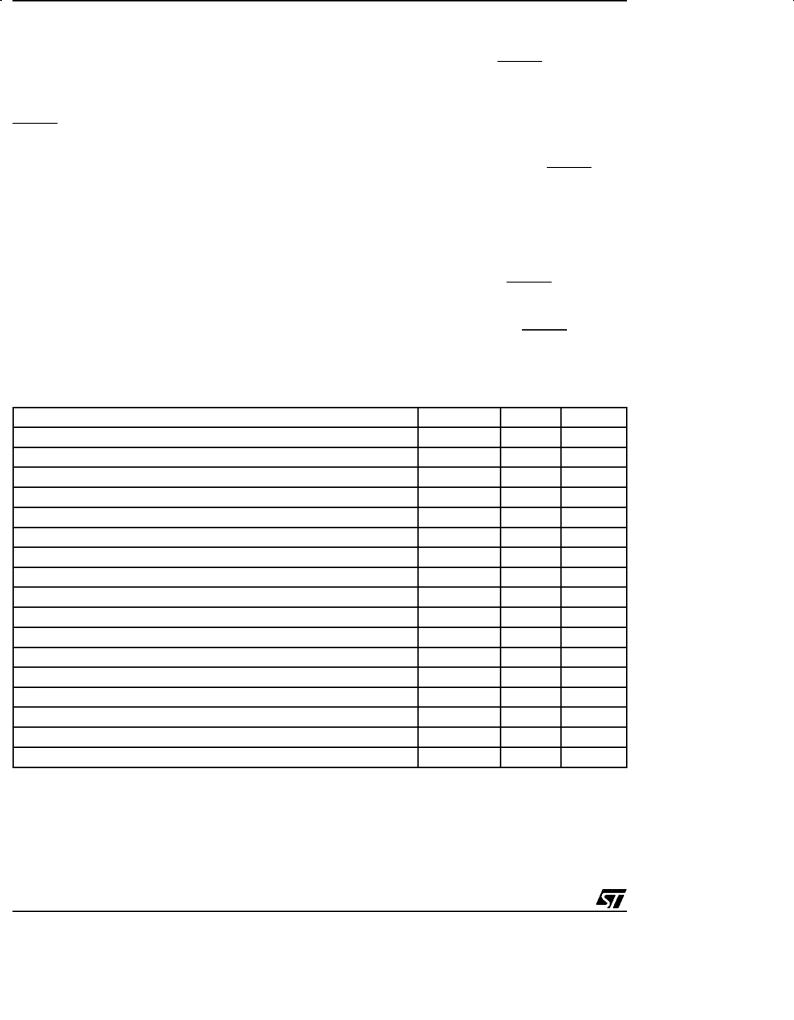
ST7263
3.2 RESET
The Reset procedure is used to provide an orderly software start-up or to exit low power modes.
Three reset modes are provided: a low voltage reset, a watchdog reset and an external reset at the RESET pin.
A reset causes the reset vector to be fetched from addresses FFFEh and FFFFh in order to be loaded into the PC and with program execution starting from this point.
An internal circuitry provides a 4096 CPU clock cycle delay from the time that the oscillator becomes active.
3.2.1 Low Voltage Reset
Low voltage reset circuitry generates a reset when VDD is:
■below VTRH when VDD is rising,
■below VTRL when VDD is falling.
During low voltage reset, the RESET pin is held low, thus permitting the MCU to reset other devices.
The Low Voltage Detector can be disabled by setting the LVD bit of the Miscellaneous Register.
3.2.2 Watchdog Reset
When a watchdog reset occurs, the RESET pin is pulled low permitting the MCU to reset other devices as when low voltage reset (Figure 11).
3.2.3 External Reset
The external reset is an active low input signal applied to the RESET pin of the MCU.
As shown in Figure 14, the RESET signal must stay low for a minimum of one and a half CPU clock cycles.
An internal Schmitt trigger at the RESET pin is provided to improve noise immunity.
Table 6. List of sections affected by RESET, WAIT and HALT (Refer to 3.5 for Wait and Halt Modes)
Section |
RESET |
WAIT |
HALT |
CPU clock running at 8 MHz |
X |
|
|
Timer Prescaler reset to zero |
X |
|
|
Timer Counter set to FFFCh |
X |
|
|
All Timer enable bit set to 0 (disable) |
X |
|
|
Data Direction Registers set to 0 (as Inputs) |
X |
|
|
Set Stack Pointer to 013Fh |
X |
|
|
Force Internal Address Bus to restart vector FFFEh,FFFFh |
X |
|
|
Set Interrupt Mask Bit (I-Bit, CCR) to 1 (Interrupt Disable) |
X |
|
|
Set Interrupt Mask Bit (I-Bit, CCR) to 0 (Interrupt Enable) |
|
X |
X |
Reset HALT latch |
X |
|
|
Reset WAIT latch |
X |
|
|
Disable Oscillator (for 4096 cycles) |
X |
|
X |
Set Timer Clock to 0 |
X |
|
X |
Watchdog counter reset |
X |
|
|
Watchdog register reset |
X |
|
|
Port data registers reset |
X |
|
|
Other on-chip peripherals: registers reset |
X |
|
|
18/107

|
ST7263 |
|
Figure 11. Low Voltage Reset functional Diagram |
Figure 12. Low Voltage Reset Signal Output |
|
RESET |
VTRH |
|
|
||
LOW VOLTAGE |
VTRL |
|
VDD |
|
|
RESET |
|
|
INTERNAL |
VDD |
|
RESET |
|
|
FROM |
|
|
WATCHDOG |
RESET |
|
RESET |
||
|
||
|
Note: Typical hysteresis (VTRH-VTRL) of 250 mV is |
|
|
expected |
Figure 13. Temporization timing diagram after an internal Reset
VTRH
VDD
temporization (4096 CPU clock cycles)
Addresses |
$FFFE |
|
Figure 14. Reset Timing Diagram
tDDR
VDD
OSCIN
tOXOV
fCPU |
|
|
PC |
FFFE |
FFFF |
RESET |
4096 CPU |
|
|
|
|
|
CLOCK |
|
|
CYCLES |
|
WATCHDOG RESET |
DELAY |
|
|
|
Note: Refer to Electrical Characteristics for values of tDDR, tOXOV, VTRH, VTRL and VTRM
19/107

ST7263
4 INTERRUPTS AND POWER SAVING MODES
4.1 INTERRUPTS
The ST7 core may be interrupted by one of two different methods: maskable hardware interrupts as listed in Table 7 Interrupt Mapping and a nonmaskable software interrupt (TRAP). The Interrupt processing flowchart is shown in Figure 15.
The maskable interrupts must be enabled clearing the I bit in order to be serviced. However, disabled interrupts may be latched and processed when they are enabled (see external interrupts subsection).
When an interrupt has to be serviced:
±Normal processing is suspended at the end of the current instruction execution.
±The PC, X, A and CC registers are saved onto the stack.
±The I bit of the CC register is set to prevent additional interrupts.
±The PC is then loaded with the interrupt vector of
the interrupt to service and the first instruction of the interrupt service routine is fetched (refer to Table 7 Interrupt Mapping for vector addresses).
The interrupt service routine should finish with the IRET instruction which causes the contents of the saved registers to be recovered from the stack.
Note: As a consequence of the IRET instruction, the I bit will be cleared and the main program will resume.
Priority management
By default, a servicing interrupt can not be interrupted because the I bit is set by hardware entering in interrupt routine.
In the case several interrupts are simultaneously pending, a hardware priority defines which one will be serviced first (see Table 7 Interrupt Mapping).
Non maskable software interrupts
This interrupt is entered when the TRAP instruction is executed regardless of the state of the I bit. It will be serviced according to the flowchart on Figure 15.
Interrupts and Low power mode
All interrupts allow the processor to leave the Wait low power mode. Only external and specific mentioned interrupts allow the processor to leave the Halt low power mode (refer to the ªExit from HALTª column in Table 7 Interrupt Mapping).
External interrupts
The pins ITi/PAk and ITj/PBk (i=1,2; j= 5,6; k=4,5) can generate an interrupt when a rising edge occurs on this pin. Conversely, pins ITl/PAn and ITm/ PBn (l=3,4; m= 7,8; n=6,7) can generate an interrupt when a falling edge occurs on this pin.
Interrupt generation will occur if it is enabled with the ITiE bit (i=1 to 8) in the ITRFRE register and if the I bit of the CCR is reset.
Peripheral interrupts
Different peripheral interrupt flags in the status register are able to cause an interrupt when they are active if both.
±The I bit of the CC register is cleared.
±The corresponding enable bit is set in the control register.
If any of these two conditions is false, the interrupt is latched and thus remains pending.
Clearing an interrupt request is done by:
±writing ª0º to the corresponding bit in the status register or
±an access to the status register while the flag is set followed by a read or write of an associated
register.
Notes:
1. The clearing sequence resets the internal latch. A pending interrupt (i.e. waiting for being enabled) will therefore be lost if the clear sequence is executed.
2.All interrupts allow the processor to leave the Wait low power mode.
3.Exit from Halt mode may only be triggered by an External Interrupt on one of the ITi ports (PA4-PA7
and PB4-PB7), an end suspend mode Interrupt coming from USB peripheral, or a reset.
20/107
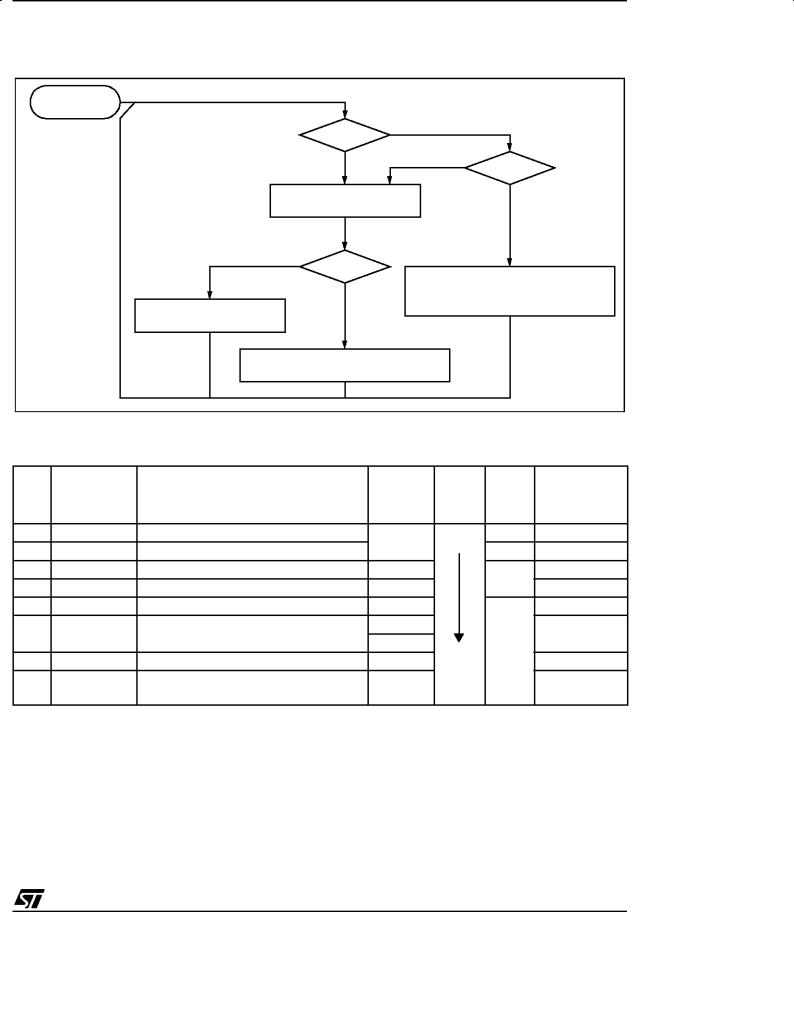
ST7263
INTERRUPTS (Cont'd)
Figure 15. Interrupt Processing Flowchart
FROM RESET
N |
|
|
BIT I SET |
|
|
Y |
N |
|
|
INTERRUPT |
|
FETCH NEXT INSTR UCTION |
Y |
|
|
||
N |
|
|
IRET |
STACK PC, X, A, CC |
|
|
||
Y |
SET I BIT |
|
LOAD PC FROM INTERRUPT VECTOR |
||
|
EXECUTE INSTRUCTION
RESTORE PC, X, A, CC FROM STACK
THIS CLEARS I BIT BY DEFAULT
Table 7. Interrupt Mapping
|
Source |
|
Register |
Priority |
Exit |
Vector |
|
N° |
Description |
from |
Address |
||||
Block |
Label |
Order |
|||||
|
|
HALT |
|
||||
|
|
|
|
|
|
||
|
RESET |
Reset |
N/A |
Highest |
yes |
FFFEh-FFFFh |
|
|
TRAP |
Software Interrupt |
Priority |
no |
FFFCh-FFFDh |
||
|
|
||||||
|
|
|
|||||
|
USB |
End Suspend Mode |
ISTR |
|
yes |
FFFAh-FFFBh |
|
1 |
ITi |
External Interrupts |
ITRFRE |
|
FFF8h-FFF9h |
||
|
|
||||||
2 |
TIMER |
Timer Peripheral Interrupts |
TIMSR |
|
|
FFF6h-FFF7h |
|
3 |
I2C |
I2C Peripheral Interrupts |
I2CSR1 |
|
|
FFF4h-FFF5h |
|
I2CSR2 |
|
|
|||||
|
|
|
|
no |
|
||
4 |
SCI |
SCI Peripheral Interrupts |
SCISR |
|
FFF2h-FFF3h |
||
Lowest |
|
||||||
5 |
USB |
USB Peripheral Interrupts |
ISTR |
Priority |
|
FFF0h-FFF1h |
|
|
|
21/107

ST7263
INTERRUPTS (Cont'd)
4.1.1 Interrupt Register
INTERRUPTS REGISTER (ITRFRE)
Address: 0008h Ð Read/Write
Reset Value: 0000 0000 (00h)
7 |
|
|
|
|
|
|
0 |
IT8E |
IT7E |
IT6E |
IT5E |
IT4E |
IT3E |
IT2E |
IT1E |
Bit 7:0 = ITiE (i=1 to 8). Interrupt Enable Control Bits.
If an ITiE bit is set, the corresponding interrupt is generated when
± a rising edge occurs on the pin PA4/IT1 or PA5/ IT2 or PB4/IT5 or PB5/IT6
or
± a falling edge occurs on the pin PA6/IT3 or PA7/ IT4 or PB6/IT7 or PB7/IT8
No interrupt is generated elsewhere.
Note: Analog input must be disabled for interrupts coming from port B.
22/107
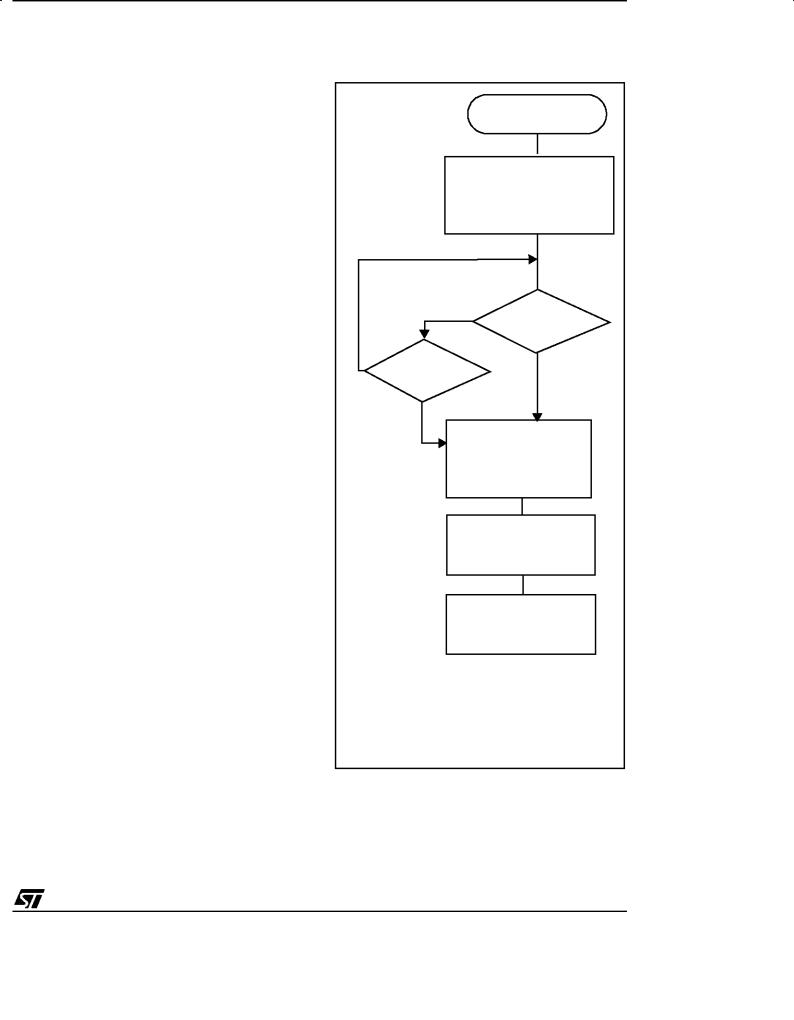
4.2 POWER SAVING MODES
4.2.1 Introduction
To give a large measure of flexibility to the application in terms of power consumption, two main power saving modes are implemented in the ST7.
After a RESET the normal operating mode is selected by default (RUN mode). This mode drives the device (CPU and embedded peripherals) by means of a master clock which is based on the main oscillator frequency divided by 3 (fCPU).
From Run mode, the different power saving modes may be selected by setting the relevant register bits or by calling the specific ST7 software instruction whose action depends on the oscillator status.
ST7263
Figure 16. HALT Mode Flow Chart
HALT INSTRUCTION
OSCILLATOR |
OFF |
PERIPH. CLOCK |
OFF |
CPU CLOCK |
OFF |
I-BIT |
CLEARED |
4.2.2 HALT mode
The HALT mode is the MCU lowest power consumption mode. The HALT mode is entered by executing the HALT instruction. The internal oscillator is then turned off, causing all internal processing to be stopped, including the operation of the on-chip peripherals.
When entering HALT mode, the I bit in the Condition Code Register is cleared. Thus, any of the external interrupts (ITi or USB end suspend mode), are allowed and if an interrupt occurs, the CPU clock becomes active.
The MCU can exit HALT mode on reception of either an external interrupt on ITi, an end suspend mode interrupt coming from USB peripheral, or a reset. The oscillator is then turned on and a stabilization time is provided before releasing CPU operation. The stabilization time is 4096 CPU clock cycles.
After the start up delay, the CPU continues operation by servicing the interrupt which wakes it up or by fetching the reset vector if a reset wakes it up.
N
RESET |
|
|
N |
|
|
EXTERNAL |
Y |
|
INTERRUPT* |
|
|
|
|
|
Y |
|
|
OSCILLATOR |
|
ON |
PERIPH. CLOCK |
|
ON |
CPU CLOCK |
|
ON |
I-BIT |
|
SET |
4096 CPU CLOCK
CYCLES DELAY
FETCH RESET VECTOR
OR SERVICE INTERRUPT
Note: Before servicing an interrupt, the CC register is pushed on the stack. The I-Bit is set during the interrupt routine and cleared when the CC register is popped.
23/107

ST7263
POWER SAVING MODES (Cont'd)
4.2.3 WAIT mode
WAIT mode places the MCU in a low power consumption mode by stopping the CPU.
This power saving mode is selected by calling the ªWFIº ST7 software instruction.
All peripherals remain active. During WAIT mode, the I bit of the CC register is forced to 0, to enable all interrupts. All other registers and memory remain unchanged. The MCU remains in WAIT mode until an interrupt or Reset occurs, whereupon the Program Counter branches to the starting address of the interrupt or Reset service routine.
The MCU will remain in WAIT mode until a Reset or an Interrupt occurs, causing it to wake up.
Refer to Figure 17.
Figure 17. WAIT Mode Flow Chart
WFI INSTRUCTION
OSCILLATOR |
ON |
PERIPH. CLOCK |
ON |
CPU CLOCK |
OFF |
I-BIT |
CLEARED |
N
RESET
N
INTERRUPT |
Y |
|
|
|
|
Y |
OSCILLATOR |
ON |
|
||
|
PERIPH. CLOCK |
ON |
|
CPU CLOCK |
ON |
|
I-BIT |
SET |
IF RESET
4096 CPU CLOCK CYCLES DELAY
FETCH RESET VECTOR
OR SERVICE INTERRUPT
Note: Before servicing an interrupt, the CC register is pushed on the stack. The I-Bit is set during the interrupt routine and cleared when the CC register is popped.
24/107
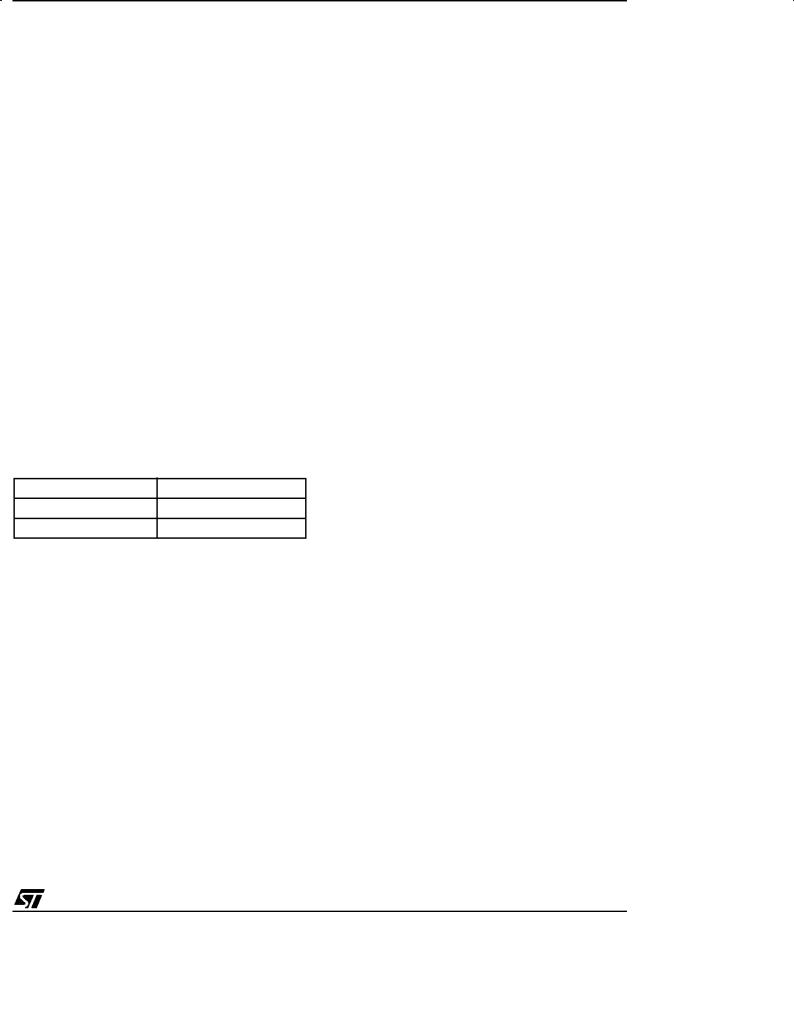
5 ON-CHIP PERIPHERALS
5.1 I/O PORTS
5.1.1 Introduction
The I/O ports offer different functional modes:
±transfer of data through digital inputs and outputs and for specific pins:
±analog signal input (ADC)
±alternate signal input/output for the on-chip peripherals.
±external interrupt generation
An I/O port is composed of up to 8 pins. Each pin can be programmed independently as digital input (with or without interrupt generation) or digital output.
5.1.2 Functional description
Each port is associated to 2 main registers:
±Data Register (DR)
±Data Direction Register (DDR)
Each I/O pin may be programmed using the corresponding register bits in DDR register: bit X corresponding to pin X of the port. The same correspondence is used for the DR register.
Table 8. I/O Pin Functions
DDR |
MODE |
0 |
Input |
1 |
Output |
Input Modes
The input configuration is selected by clearing the corresponding DDR register bit.
In this case, reading the DR register returns the digital value applied to the external I/O pin.
Note 1: All the inputs are triggered by a Schmitt trigger.
Note 2: When switching from input mode to output mode, the DR register should be written first to output the correct value as soon as the port is configured as an output.
Interrupt function
When an I/O is configured in Input with Interrupt, an event on this I/O can generate an external In-
ST7263
terrupt request to the CPU. The interrupt sensitivity is given independently according to the description mentioned in the ITRFRE interrupt register.
Each pin can independently generate an Interrupt request.
Each external interrupt vector is linked to a dedicated group of I/O port pins (see Interrupts section). If more than one input pin is selected simultaneously as interrupt source, this is logically ORed. For this reason if one of the interrupt pins is tied low, it masks the other ones.
Output Mode
The pin is configured in output mode by setting the corresponding DDR register bit (see Table 7).
In this mode, writing ª0º or ª1º to the DR register applies this digital value to the I/O pin through the latch. Then reading the DR register returns the previously stored value.
Note: In this mode, the interrupt function is disabled.
Digital Alternate Function
When an on-chip peripheral is configured to use a pin, the alternate function is automatically selected. This alternate function takes priority over standard I/O programming. When the signal is coming from an on-chip peripheral, the I/O pin is automatically configured in output mode (push-pull or open drain according to the peripheral).
When the signal is going to an on-chip peripheral, the I/O pin has to be configured in input mode. In this case, the pin's state is also digitally readable by addressing the DR register.
Notes:
1.Input pull-up configuration can cause an unexpected value at the input of the alternate peripheral input.
2.When the on-chip peripheral uses a pin as input and output, this pin must be configured as an input
(DDR = 0).
Warning: The alternate function must not be activated as long as the pin is configured as input with interrupt, in order to avoid generating spurious interrupts.
25/107

ST7263
I/O PORTS (Cont'd)
Analog Alternate Function
When the pin is used as an ADC input the I/O must be configured as input, floating. The analog multiplexer (controlled by the ADC registers) switches the analog voltage present on the selected pin to the common analog rail which is connected to the ADC input.
It is recommended not to change the voltage level or loading on any port pin while conversion is in progress. Furthermore it is recommended not to
have clocking pins located close to a selected analog pin.
Warning: The analog input voltage level must be within the limits stated in the Absolute Maximum Ratings.
5.1.3 I/O Port Implementation
The hardware implementation on each I/O port depends on the settings in the DDR register and specific feature of the I/O port such as ADC Input or true open drain.
26/107
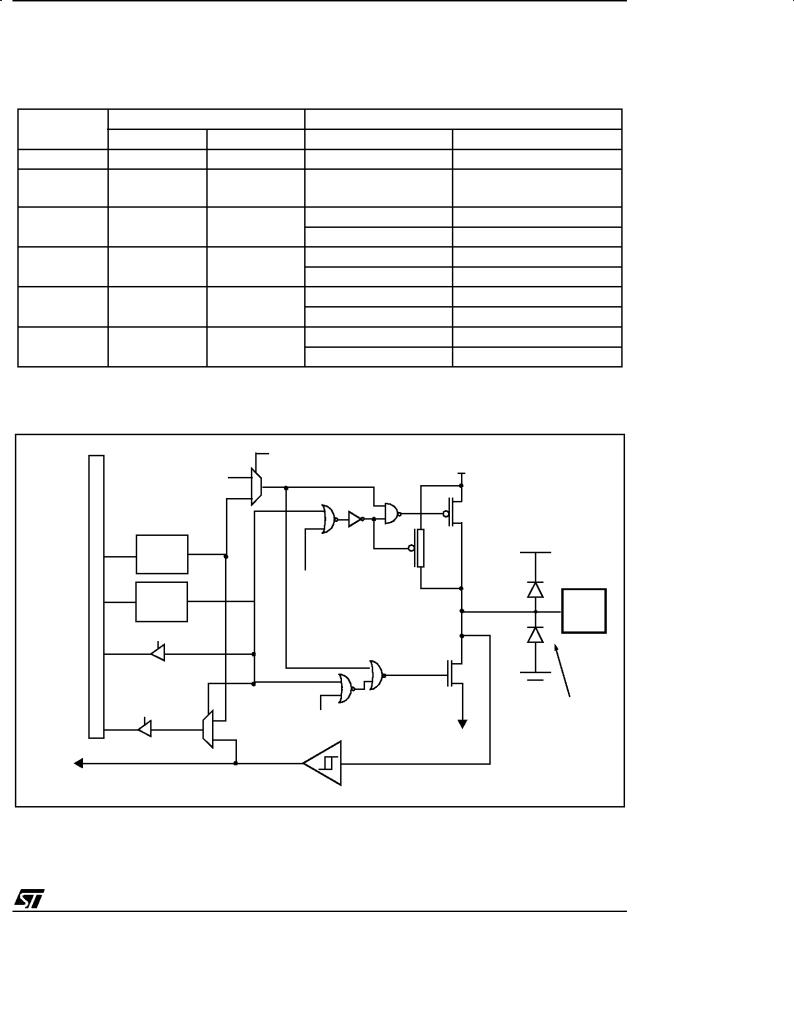
ST7263
I/O PORTS (Cont'd)
5.1.4 Port A
Table 9. Port A0, A3, A4, A5, A6, A7 Description
PORT A |
|
I / O |
|
Input* |
Output |
||
|
|||
PA0 |
with pull-up |
push-pull |
|
PA3 |
with pull-up |
push-pull |
|
PA4 |
with pull-up |
push-pull |
|
|
|
||
PA5 |
with pull-up |
push-pull |
|
|
|
||
PA6 |
with pull-up |
push-pull |
|
|
|
||
PA7 |
with pull-up |
push-pull |
|
|
|
||
*Reset State |
|
|
Alternate Function
Signal |
Condition |
|
MCO (Main Clock Output) |
MCO = 1 (MISCR) |
|
Timer EXTCLK |
CC1 =1 |
|
CC0 = 1 (Timer CR2) |
||
|
||
Timer ICAP1 |
|
|
IT1 Schmitt triggered input |
IT1E = 1 (ITIFRE) |
|
Timer ICAP2 |
|
|
IT2 Schmitt triggered input |
IT2E = 1 (ITIFRE) |
|
Timer OCMP1 |
OC1E = 1 |
|
IT3 Schmitt triggered input |
IT3E = 1 (ITIFRE) |
|
Timer OCMP2 |
OC2E = 1 |
|
IT4 Schmitt triggered input |
IT4E = 1 (ITIFRE) |
Figure 18. PA0, PA3, PA4, PA5, PA6, PA7 Configuration
ALTERNATE 1
OUTPUT
0
|
DR |
DATA |
LATCH |
|
|
BUS |
DDR |
|
|
|
LATCH |
|
DDR SEL |
DR SEL |
1 |
ALTERNATE INPUT |
0 |
ALTERNATE ENABLE
VDD
P-BUFFER
VDD
PULL-UP
ALTERNATE ENABLE
PAD
N-BUFFER
DIODES
ALTERNATE ENABLE
VSS
CMOS SCHMITT TRIGGER
27/107
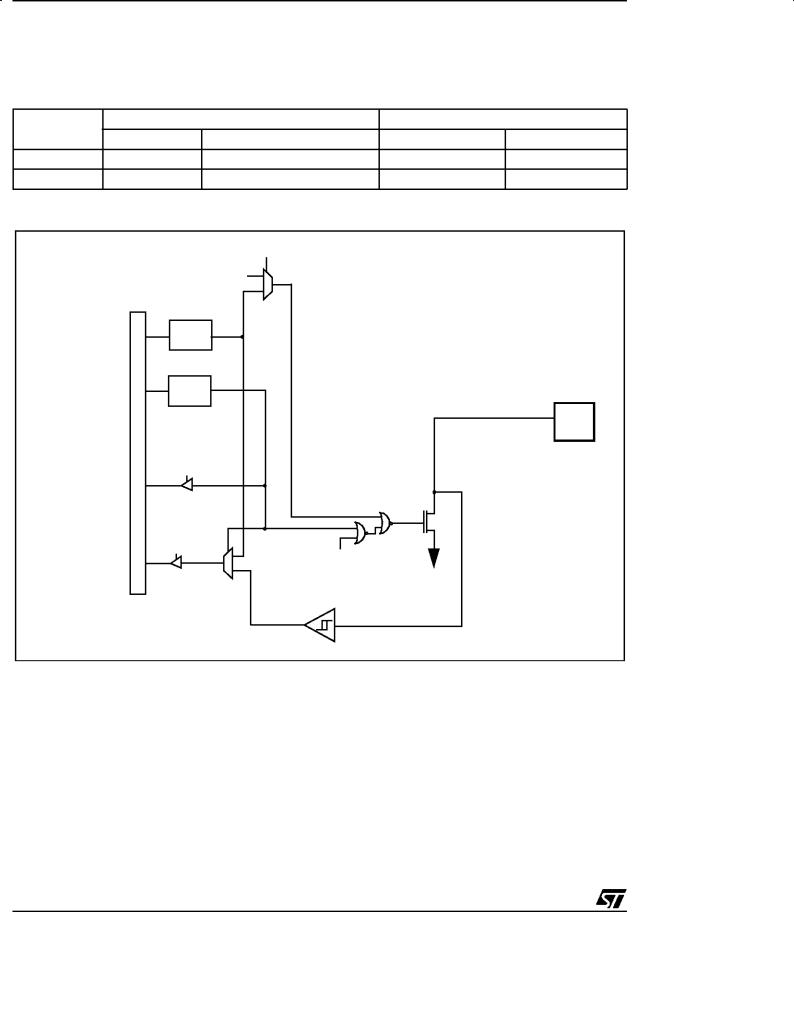
ST7263
I/O PORTS (Cont'd)
Table 10. PA1, PA2 Description
PORT A |
|
I / O |
Alternate Function |
||
Inpu t* |
Output |
Signal |
Condition |
||
|
|||||
PA1 |
without pull-up |
Very High Current open drain |
SDA (I2C data) |
I2C enable |
|
PA2 |
without pull-up |
Very High Current open drain |
SCL (I2C clock) |
I2C enable |
|
*Reset State |
|
|
|
|
|
Figure 19. PA1, PA2 Configuration
ALTERNATE ENABLE
ALTERNATE 1
OUTPUT
0
DR
LATCH
DDR
LATCH
BUS DATA
DDR SEL |
|
|
|
|
N-BUFFER |
DR SEL |
1 |
ALTERNATE ENABLE |
|
|
|
|
0 |
VSS |
|
|
CMOS SCHMITT TRIGGER |
PAD
28/107

ST7263
I/O PORTS (Cont'd)
5.1.5 Port B
Table 11. Port B Description
PORT B |
|
I/O |
Alternate Function |
||
|
Input* |
Output |
Signal |
Condit ion |
|
PB0 |
without pull-up |
push-pull |
Analog input (ADC) |
CH[2:0] = 000 (ADCCSR) |
|
PB1 |
without pull-up |
push-pull |
Analog input (ADC) |
CH[2:0] = 001 (ADCCSR) |
|
PB2 |
without pull-up |
push-pull |
Analog input (ADC) |
CH[2:0]= 010 (ADCCSR) |
|
PB3 |
without pull-up |
push-pull |
Analog input (ADC) |
CH[2:0]= 011 (ADCCSR) |
|
PB4 |
without pull-up |
push-pull |
Analog input (ADC) |
CH[2:0]= 100 (ADCCSR) |
|
IT5 Schmitt triggered input |
IT4E = 1 (ITIFRE) |
||||
|
|
|
|||
PB5 |
without pull-up |
push-pull |
Analog input (ADC) |
CH[2:0]= 101 (ADCCSR) |
|
IT6 Schmitt triggered input |
IT5E = 1 (ITIFRE) |
||||
|
|
|
|||
PB6 |
without pull-up |
push-pull |
Analog input (ADC) |
CH[2:0]= 110 (ADCCSR) |
|
IT7 Schmitt triggered input |
IT6E = 1 (ITIFRE) |
||||
|
|
|
|||
PB7 |
without pull-up |
push-pull |
Analog input (ADC) |
CH[2:0]= 111 (ADCCSR) |
|
IT8 Schmitt triggered input |
IT7E = 1 (ITIFRE) |
||||
|
|
|
|||
*Reset State
Figure 20. Port B Configuration
ANALOG COMMON |
BUS DATA |
RAIL |
|
|
ALTERNATE ENABLE |
|
ALTERNATE 1 |
VDD |
|
OUTPUT |
0 |
|
|
VDD |
|
|
|
|
DR |
|
P-BUFFER |
LATCH |
|
|
|
ALTERNATE ENABLE |
|
DDR |
|
PAD |
LATCH |
|
|
|
|
|
|
ANALOG ENABLE |
|
|
(ADC) |
|
DDR SEL |
ANALOG |
|
|
|
|
|
SWITCH |
DIODES |
|
|
N-BUFFER |
DR SEL |
1 |
|
ALTERNATE ENABLE |
|
|
|
|
|
|
DIGITAL ENABLE |
VSS |
|
0 |
|
ALTERNATE INPUT
29/107
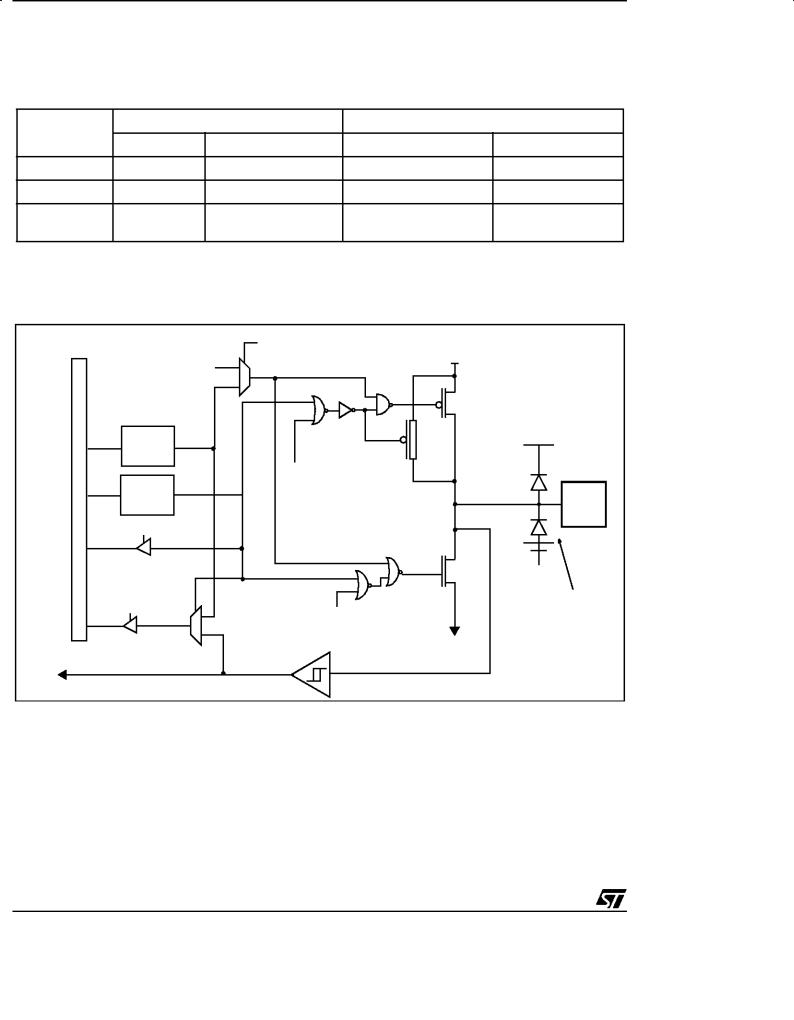
ST7263
I/O PORTS (Cont'd)
5.1.6 Port C
Table 12. Port C Description
PORT C |
I / O |
Alternate Function |
|
|
|
|
|
Input* |
Output |
Signal |
Conditio n |
PC0 |
with pull-up |
push-pull |
PC1 |
with pull-up |
push-pull |
PC2 |
with pull-up |
push-pull |
*Reset State |
|
|
RDI (SCI input) |
|
TDO (SCI output) |
SCI enable |
USBOE (USB output ena- |
USBOE =1 |
ble) |
(MISCR) |
Figure 21. Port C Configuration
ALTERNATE1
OUTPUT
0
|
DR |
|
|
LATCH |
|
DATA |
DDR |
|
|
||
BUS |
LATCH |
|
DDR SEL |
||
|
DR SEL |
1 |
0
ALTERNATE INPUT
ALTERNATE ENABLE
VDD
P-BUFFER
VDD
PULL-UP
ALTERNATE ENABLE
PAD
N-BUFFER
DIODES
ALTERNATE ENABLE
VSS
CMOS SCHMITT TRIGGER
30/107
